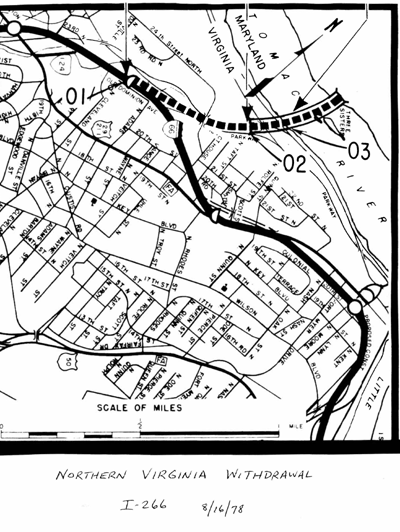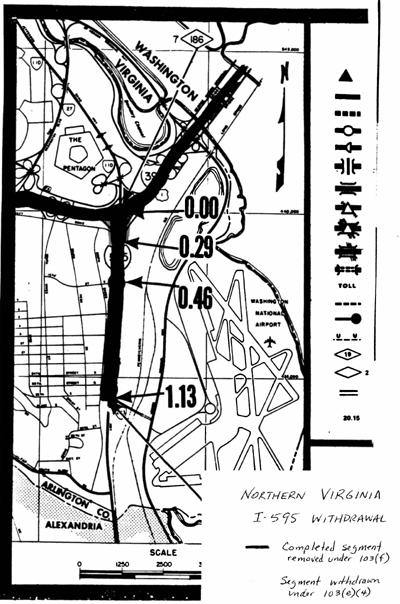In 1998, with the Interstate System essentially complete, FHWA's Office of Engineering compiled information about development of the program. In making this information available to the public, we have not updated the material. All information is as of 1998 when the Office of Engineering compiled the report.
The Dwight D. Eisenhower System of Interstate and Defense Highways
Part V - Interstate Withdrawal-Substitution Program
Interstate Withdrawal-Substitution Program Legislative History and Related Information
Background
Many urban Interstate segments were built as planned and designed. Others were modified to meet local conditions and concerns and were also constructed. But other routes, nearly all in urban areas, became extremely controversial with localities, local citizens, environmentalists, and others and were never built. Beginning in 1968 and 1973, legislation was enacted providing an alternative to constructing these planned segments.
Public Law 90-238
Commonly known as the Howard-Cramer provision, this 1968 act provided for minor adjustments to the Interstate System if no additional costs were incurred. In effect, upon approval by the Secretary, a State could built another Interstate segment of equal cost in lieu of the withdrawn segment. The act authorized an additional 200 Interstate miles to facilitate the modifications. Later legislation increased the available mileage to 500 and removed the equal cost provision.
Federal-Aid Highway Act of 1973 (P. L. 93-87)
Section 137(b) of this act modified Section 103(e)(2) of Title 23 and provided that upon the joint request of the State Governor and local governments concerned, the Secretary could withdraw his/her approval of unbuilt Interstate routes or portions thereof within an urbanized area, if he/she determined that the withdrawn segment was not essential to completion of a unified and connected system. Transit projects in or serving the same urbanized area could be substituted for the withdrawn segment with funding from the General Fund in an amount equal to the Federal share of the withdrawn Interstate facility as reported in the Interstate Cost Estimate (ICE).
Federal-Aid Highway Amendments of 1974 (P.L. 93-643)
Section 125 of this act revised the substitute funding entitlement, providing that the ICE base cost be increased or decreased in accordance with variations in the cost of construction. The FHWA made these cost adjustments by use of its Bid Price Index.
Federal-Aid Highway Act of 1976 (P.L. 94-280)
Section 110 of this act modified 23 U.S.C. 103(e)(4) and permitted the withdrawal of segments connecting urbanized areas within a State and the substitution of highway projects in addition to non-highway transit projects.
Federal-Aid Highway Act of 1978 (P.L. 95-599)
Section 107 of the act prohibited further withdrawals after September 30, 1983, except for certain routes under injunction. This was the case for the withdrawal on September 30, 1985, of Westway (I-478) in New York City.
The Surface Transportation Assistance Act of 1982
Section 107 of this act further extended the provisions to rural segments and authorized funding from the Highway Trust Fund of substitute highway projects.
The section also terminated the adjustments to withdrawal value, or entitlement, based on variations in the cost of construction.
Surface Transportation and Uniform Assistance Act of 1987 (P.L. 100-17)
Section 103 of this act provided that a substitute project no longer had to be on the Federal-Aid system but may be on any public road; eliminated the deadline for having substitute projects under construction; and required the Secretary, if right-of-way for a withdrawn section had not been disposed of, to hold in reserve an amount equal to that expended on the right-of-way until the funds were repaid or the Secretary determined that repayment was not required.
Section 141 allowed for the withdrawal of planned added lanes on the Harbor Freeway (I-110) in Los Angeles, CA, and substitution of transit projects. However, the State did not make use of the provision and constructed the added lanes as planned.
Section 142 provided for withdrawal of a specific project - bus lanes on an otherwise completed section of I-205 in Portland, Oregon.
Intermodal Surface Transportation Efficiency Act (ISTEA) of 1991 (P.L. 102-240)
Section 1011 of ISTEA provided that substitute highway funds may be used for substitute transit projects. The act also eliminated the discretionary funding component of the program and provided that all authorized funds be apportioned on the basis of an annually updated cost-to-complete. The final authorization for the program was established for FY 1995.
Section 1045 of ISTEA (as amended by Section 335 of the 1995 DOT Appropriations Act) provided for the use of Interstate Construction funds intended for the East-West Transitway (Busway) along the I-94 corridor in Milwaukee, Wisconsin for substitute highway and transit projects. On 10/7/94, the Secretary approved the Governor's request for a substitute transit facility for buses and multi-occupant vehicles along I-94 from downtown Milwaukee to STH 164 near Waukesha. Since IC funds are available for nearly all of the entitlement, separate Highway Trust Fund authorizations for the project have not been made. The FY 1995 DOT Appropriations Act did make available $9.5 million in General Funds to FTA for the project. The Wisconsin action is not counted in the following data on Interstate Withdrawals.
Summary
Legislative authority for this program is codified in Section 103(e)(4) of Title 23. Administrative rules and regulations are provided in 23 CFR 476.
A total of 50 separate actions involving the withdrawal of 343 miles of Interstate Highways have been approved under the Withdrawal-Substitution Program at a base cost of $9.771 billion. There are 32 withdrawal areas located in 21 States. Withdrawal areas are urbanized areas in which one or more Interstate withdrawals were approved.
The first withdrawal was approved for Boston's Inner Belt (I-95 and I-695) on May 23, 1974, and the final one was approved on September 22, 1989, in accordance with P.L. 100-17 for bus lanes on I-205 in Portland, Oregon.
Each of the withdrawal-substitution approvals was jointly made by the Administrators of FHWA and the Federal Transit Administration (formerly UMTA). These approvals established the eligibility of Federal substitute project funding.
The substitute funds made available to the States, taking into account the base cost and the escalation clause provided by the 1974 act, total $8.2 billion for substitute highway projects and $6.7 billion for substitute transit projects.
Redesignations
The withdrawn mileage became available for redesignation in another State and numerous such redesignation actions were taken. In a couple cases, the redesignated mileage was also later withdrawn amid growing controversy. This came to a head with the withdrawal of I-165 in Indianapolis, Indiana.
Route 165 was added to the Interstate System on June 6, 1978, using mileage available from withdrawals in other States. In his letter of that date, Acting Administrator Karl S. Bowers included the condition that I-165 could not later be withdrawn under the provisions of 23 U.S.C. 103(e)(2), or 103(e)(4). This condition was based on the policy that mileage could only be withdrawn once. To permit redesignated mileage to be withdrawn would incur a second entitlement for substitute funds.
Sections 107(a)(1) and (b) of the Surface Transportation Assistance Act of 1978 prohibited any future Interstate additions or redesignations under 23 U.S.C. 103(e)(2) or 103(e)(4) after November 6, 1978. As a result the redesignations ended and the concern expressed in the I-165 condition was reduced since these multiple withdrawals of the same mileage could no longer be redesignated. Accordingly, on August 25, 1980, Administrator John S. Hassell wrote the Indiana State Highway Commission rescinding the condition in Mr. Bowers's 1978 letter. Approval of the I-165 withdrawal on July 30, 1981, in Administrator R. A. Barnhart's letter to Indiana Governor Orr.
There were at least three other examples of approvals of withdrawals of redesignated mileage, I-380 in Waterloo, Iowa; I-35 in Duluth, Minnesota; and I-580 in Omaha, Nebraska.
Howard-Cramer Interstate Route Additions
P.L. 90-238 (Enacted 1/2/68)
This act, which was separate from any major highway act, amended Section 103(d) of Title 23 [later renumbered as 23 U.S.C. 103(e)(2)] in order to provide sufficient mileage to enable affected States and the Secretary of Transportation to meet the problems which had been encountered in attempting to construct certain mostly urban Interstate segments.
Under the act, if a State and the Secretary agreed that a portion of an Interstate route was not essential to a unified and connected system and would not be constructed as part of the System, the Secretary could redesignate the withdrawn mileage, with or without additional miles from the 200 miles made available by the act, to other Interstate routes or route portions.
The act required that the cost of all mileage used for these modifications would be no greater than the cost of the withdrawn mileage as reported in the 1965 Interstate Cost Estimate (ICE).
Federal-Aid Highway Act of 1973 (P.L. 93-86)
Section 137 of this act amended 23 U.S.C. 103(e)(2) and increased the additional mileage for the Howard-Cramer modifications from 200 to 500 miles. It also revised the cost limitation to that amount included in the 1972 ICE.
Surface Transportation Assistance Act of 1978 (P.L. 95-599)
Section 107 of this act further amended 23 U.S.C. 103(e)(2) and removed the provision limiting Interstate Construction funding to the amount reported in the 1972 ICE. As a result the Howard-Cramer route additions were funded at a full 90 percent Federal share, the same as all other Interstate routes designated under Section 103(e).
Section 107 also amended 103(e)(2) by terminating the redesignation of any Interstate mileage under Section 103(e)(2) after the 1978 act enactment date, November 6, 1978.
Howard-Cramer Designations
The 103(e)(2) provision was used to withdraw 93.6 miles from 17 Interstate routes in 8 States and substitute 15 new routes, or additions to existing routes, in 9 States.
The withdrawn mileage was used along with 402.62 miles from the Howard-Cramer pool resulting in 481.48 miles of new segments as shown in the following table and maps.
| State | Withdrawn Route | Location of Withdrawn Route | Substitute Route(s) | Description of Substitute Route | ||||
|---|---|---|---|---|---|---|---|---|
| Route | Length (Miles) | Route | Total Length | e(1) Miles | e(2) Miles | |||
| California | I-80 | 5.2 | S Francisco | I-105 | 17.30 | 10.30 | 7.00 | Century Freeway in Los Angeles |
| I-480 | 5.5 | S Francisco |
| |||||
| I-280 | 6.7 | S Francisco | ||||||
| I-105 | 1.3 | Los Angeles | ||||||
| I-110 | 0.7 | Los Angeles | ||||||
| Connecticut | I-86 | 0.8 | Hartford | I-691 | 8.29 | 1.60 | 6.69 | From east of I-84 to I-91 at Meriden |
| I-291 | 3.1 | |||||||
| Florida | See footnote below. | I-75 | 46.31 | 0.00 | 46.31 | Tampa Bypass - From Bradenton to I-275 north of Tampa | ||
| Georgia | I-485 | 5.5 | Atlanta | I-520 | 10.11 | 1.00 | 9.11 | Augusta Loop |
| I-575 | 30.86 | 1.70 | 29.16 | Spur from I-75 at Marietta, north | ||||
| I-675 | 10.25 | 2.47 | 7.78 | Connector south of Atlanta | ||||
| Louisiana | I-410 | 34.1 | New Orleans | I-49 | 187.28 | 34.10 | 153.18 | From U.S. 190 at Opelousas to U.S. 84 at Grand Bayou |
| Massachusetts | I-95 | 2.6 | Boston | I-495 | 12.90 | 0.00 | 12.90 | From S.R. 24 to I-95, south of Boston |
| Maryland | I-70S | 1.6 | Montgomery County | I-97 | 17.57 | 2.67 | 14.90 | From U.S. 50 at Annapolis to I-695 at Baltimore |
| I-195 | 3.53 | 1.33 | 2.20 | Spur to BWI Airport | ||||
| I-95 | 5.1 | Prince Georges Co | I-370 | 2.67 | 1.49 | 1.18 | Spur from I-270 to Shady Grove Metro Station | |
| I-595 | 20.11 | 0.80 | 19.31 | U.S. 50 from Capital Beltway to Annapolis | ||||
| New Jersey | I-278 | 7.0 | Elizabeth | I-195 | 34.30 | 7.00 | 27.30 | From NJ Turnpike east of Trenton to Garden State Parkway |
| New York | I-78 | 3.4 | New York City | I-390 | 74.90 | 14.40 | 60.50 | From Southern Tier Expwy (SR-17) to I-490 at Rochester |
| I-478 | 1.6 | |||||||
| I-878 | 4.2 | I-590 | 5.10 | 0.00 | 5.10 | From I-390 to I-490 at Rochester | ||
| I-295 | 5.2 | |||||||
| Totals | 93.6 | 481.48 | 78.86 | 402.62 | ||||
Footnotes:
| ||||||||
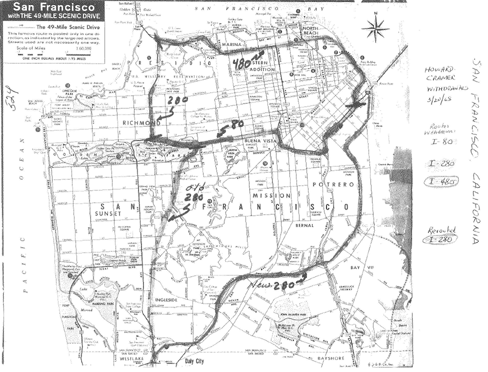
San Francisco, CA
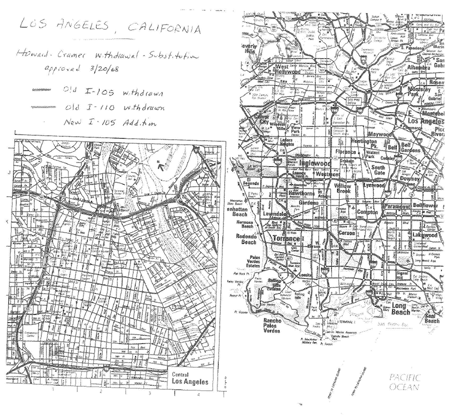
Los Angeles, CA
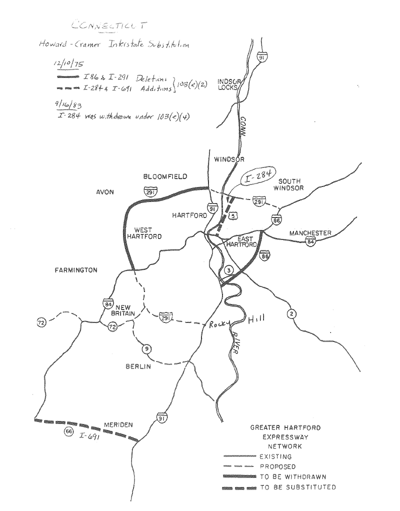
Greater Hartford Expressway Network in Connecticut
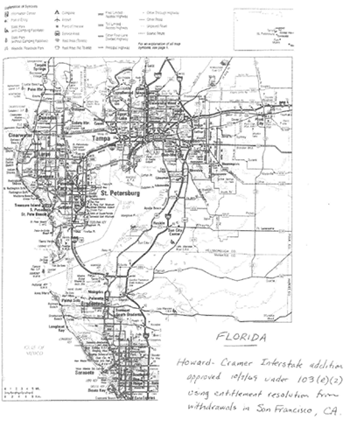
Tampa/St. Petersburg, FL
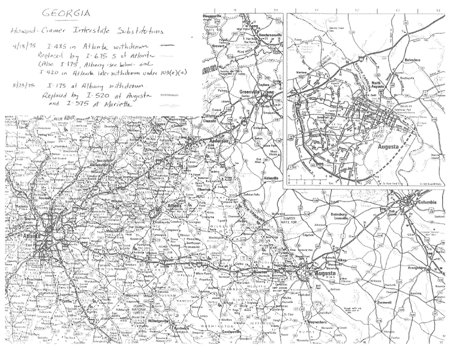
Atlanta and Augusta, GA
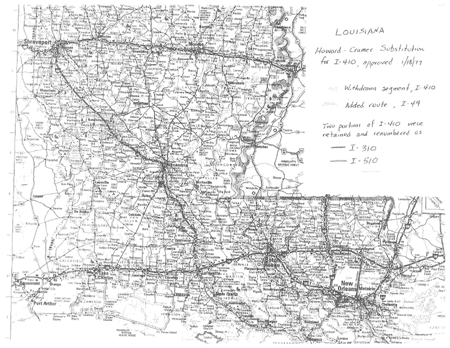
Louisiana
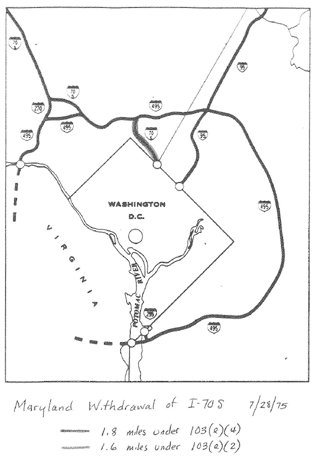
Maryland
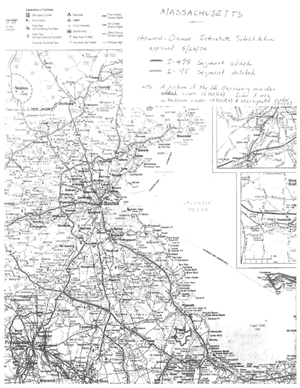
Massachusetts
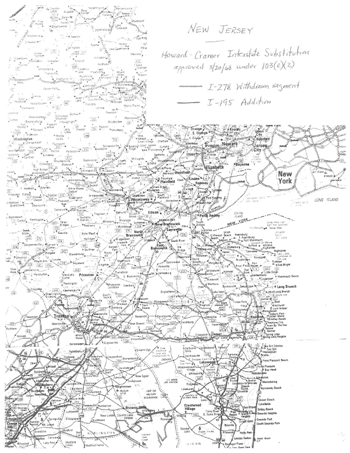
New Jersey
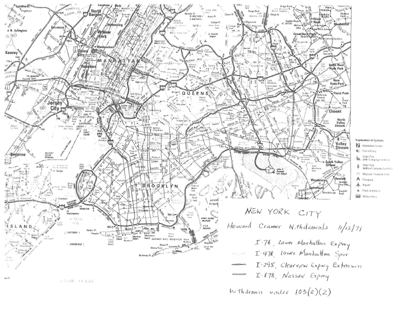
New York City
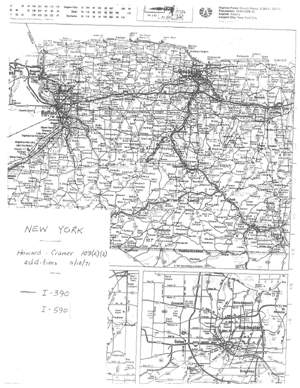
New York
| State | Route | Withdrawal Area | Length (Miles) | Base Cost ($Millions) | Approval Date |
|---|---|---|---|---|---|
| Arizona | I-710 | Tucson | 3.20 | 29.2 | 5/23/77 |
| California | I-80 | Sacramento | 5.10 | 57.7 | 5/15/80 |
| I-280 | San Francisco | 1.90 | 54.3 | 1/16/81 | |
| Colorado | I-470 | Denver | 26.30 | 153.2 | 9/30/77 |
| I-86, 291 (1st Stage) | Hartford-New Britain | 13.50 | 189.4 | 12/10/75 | |
| I-491 (2nd Stage) | Hartford-New Britain | 8.20 | 81.3 | 8/26/80 | |
| Connecticut | I-284 (3rd Stage) | Hartford-New Britain | 3.10 | 29.6 | 9/16/83 |
| I-484 (4th Stage) | Hartford-New Britain | 0.80 | 35.9 | 9/29/83 | |
| I-84 (West) | Bolton to Killingly | 28.80 | 307.7 | 9/29/83 | |
| I-84 (East) | Bolton to Killingly | 4.70 | 36.9 | 9/29/83 | |
| I-70S, 95 (1st Stage) | Washington | 5.40 | 304.3 | 10/03/75 | |
| I-66, 266 (2nd Stage) | Washington | 2.50 | 300.6 | 4/29/77 | |
| District of Columbia | I-295,395 (3rd Stage) | Washington | 4.70 | 403.5 | 9/08/78 |
| I-695 (4th Stage) | Washington | 1.70 | 230.4 | 8/27/80 | |
| I-266 (5th Stage) | Washington | 0.60 | 110.2 | 6/28/82 | |
| I-66, 266 (6th Stage) | Washington | 0.80 | 121.8 | 8/19/83 | |
| Georgia | I-420 | Atlanta | 5.40 | 96.4 | 9/29/83 |
| Illinois | I-494 (1st Stage) | Chicago | 6.30 | 453.1 | 9/30/77 |
| I-494 (2nd Stage) | Chicago | 13.60 | 1,011.3 | 10/01/79 | |
| Indiana | I-165 | Indianapolis | 2.70 | 52.6 | 7/30/81 |
| Iowa | I-380 | Waterloo | 7.30 | 189.2 | 11/25/81 |
| Massachusetts | I-95, 695 | Boston | 24.70 | 637.7 | 5/23/74 |
| I-895 | Fall River to Providence | 1.50 | 12.2 | 10/15/82 | |
| I-70S | Washington | 1.80 | 77.2 | 7/28/75 | |
| Maryland | I-70 (1st Stage) | Baltimore | 3.30 | 129.5 | 9/03/81 |
| I-83,595 (2nd Stage) | Baltimore | 5.60 | 738.9 | 9/29/83 | |
| I-297 | Bowie to Millersville | 8.90 | 80.0 | 9/29/83 | |
| Minnesota | I-335 | Minneapolis-St Paul | 2.70 | 71.2 | 7/28/78 |
| I-35 | Duluth | 4.10 | 44.7 | 3/16/81 | |
| Nebraska | I-580 | Omaha | 1.90 | 47.0 | 12/14/79 |
| I-495 (1st Stage) | New York City | 2.10 | 35.7 | 9/14/79 | |
| New Jersey | I-895 | Philadelphia | 4.30 | 71.3 | 9/30/80 |
| I-95 (2nd Stage) | New York City | 9.70 | 73.0 | 1/19/81 | |
| I-95, 695 | New York City to Trenton | 22.80 | 210.9 | 3/03/83 | |
| I-687 | Albany | 3.60 | 35.2 | 7/14/78 | |
| New York | I-495 (1st Stage) | New York City | 4.70 | 118.7 | 6/29/79 |
| I-478 (2nd Stage) | New York City | 4.30 | 1,608.0 | 9/30/85 | |
| Ohio | I-490 | Cleveland | 7.90 | 147.9 | 11/13/79 |
| I-80N (1st Stage) | Portland | 5.10 | 145.5 | 5/03/76 | |
| Oregon | I-305 | Salem | 3.30 | 32.5 | 9/30/77 |
| I-505 (2nd Stage) | Portland | 3.20 | 98.6 | 12/14/79 | |
| I-205 (Bus Lanes) | Portland | N/A | 16.4 | 9/22/89 | |
| I-695 (1st Stage) | Philadelphia | 7.80 | 148.2 | 6/25/74 | |
| Pennsylvania | I-579 | Pittsburgh | 0.40 | 39.5 | 12/14/79 |
| I-895 (2nd Stage) | Philadelphia | 2.10 | 81.9 | 9/30/80 | |
| Rhode Island | I-895 (1st Stage) | Rhode Island | 39.60 | 479.1 | 5/20/83 |
| I-84 (2nd Stage) | Rhode Island | 16.00 | 112.0 | 9/20/83 | |
| Tennessee | I-40 | Memphis | 3.80 | 171.6 | 1/16/81 |
| Virginia | I-266 (1st Stage) | Washington | 0.40 | 35.6 | 8/16/78 |
| I-595 (2nd Stage) | Washington | 0.80 | 22.6 | 8/27/82 | |
| Totals | 50 Withdrawal Actions | 343.00 | 9,770.9 |
Withdrawal of I-710 -- Tucson, Arizona
Description of Withdrawn Route
Interstate Route 710 was originally designed as a 3.2 mile urban penetration spur in the Tucson metropolitan area. It was proposed to start at a junction with I-10 near the intersection of Campbell Avenue and Ajo Way and progress north to Park Avenue in the center of Tucson.
Withdrawal Action
On March 8, 1977, Governor Raul H. Castro submitted a joint request by the State of Arizona, the City of Tucson, and the Pima Association of Governments for the withdrawal of I-710 from the Interstate System with the intent to substitute public mass transit and street improvement projects.
On May 23, 1977, Federal Highway Administrator William M. Cox and Acting Urban Mass Transportation Administrator Charles F. Bingham approved the withdrawal under the provisions of 23 U.S.C. 103(e)(4).
In accordance with Section 103(e)(4), Arizona's unobligated balance of Interstate Construction (IC) funds was reduced by approximately $5.0 million on the date of the withdrawal. The reduction was accomplished by decreasing Arizona's IC apportionment for FY 1977.
Withdrawal Value
The "Base" withdrawal value was based on the Federal share of the cost to complete I-710 as reported in the Interstate Cost Estimate (ICE) at the time of the withdrawal. The Base cost was adjusted quarterly to determine a new withdrawal value in accordance with Section 125 of the Federal-Aid Highway Amendments of 1974 reflecting variations in the cost of construction. The adjustment due to construction cost variances was terminated by the Surface Transportation Assistance Act of 1982. These values are shown in the following table:
| Base Cost (1975 ICE) | 29.2 million |
| Obligations for Highway Projects | 67.4 million |
| Obligations for Transit Projects | 1.1 million |
| Remaining Entitlement | 0.1 million |
| Final Withdrawal Value | 68.7 million |
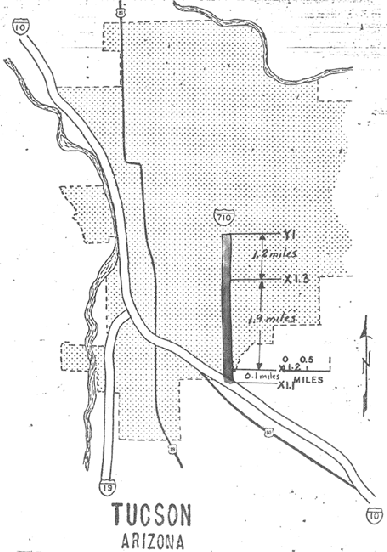
Withdrawal of I-80 -- Sacramento, California
Description of Withdrawn Route
Interstate Route 80 was originally planned along a 5.1-mile new alignment between "C" Street and (old) I-880 in Sacramento.
Withdrawal Action
On January 11, 1980, Governor Edmund G. Brown, Jr. submitted a joint request by the State of California and the City of Sacramento for the withdrawal of a portion of I-80 from the Interstate System.
On May 15, 1980, Deputy Federal Highway Administrator John Hassell, Jr. and Urban Mass Transportation Administrator Theodore C. Lutz approved the withdrawal under the provisions of 23 U.S.C. 103(e)(4).
Route continuity for I-80 was maintained by shifting the I-80 designation to the existing I-880 loop around the west and north sides of Sacramento.
In accordance with Section 103(e)(4), California's unobligated balance of Interstate Construction (IC) funds was reduced by approximately $6.1 million on the date of the withdrawal. The reduction was accomplished by reducing California's FY 1979 Gap Closing apportionment and FY 1980 IC apportionment.
Withdrawal Value
The "Base" withdrawal value was based on the Federal share of the cost to complete I-80 as reported in the Interstate Cost Estimate (ICE) at the time of the withdrawal. The Base cost was adjusted quarterly to determine a new withdrawal value in accordance with Section 125 of the Federal-Aid Highway Amendments of 1974 reflecting variations in the cost of construction. The adjustment due to construction cost variances was terminated by the Surface Transportation Assistance Act of 1982. These values are shown in the following table:
| Base Cost (1979 ICE) | 57.7 million |
| Obligations for Highway Projects | 0.0 million |
| Obligations for Transit Projects | 96.3 million |
| Remaining Entitlement | 0.1 million |
| Final Withdrawal Value | 96.4 million |
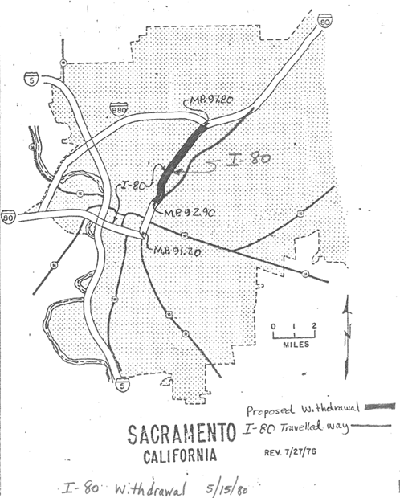
Withdrawal of I-280 -- San Francisco, California
Description of Withdrawn Route
Interstate Route 280 was originally planned to extend from San Jose to the western terminus of I-80 in San Francisco. The withdrawn portion includes a 1.9 mile segment of the Embarcadero Freeway connection to I-80 at the western end of the San Francisco-Oakland Bay Bridge. A 0.5 mile portion of the withdrawn segment was previously constructed as an elevated structure.
Withdrawal Action
In late 1980 via an undated letter, Governor Edmund G. Brown, Jr. submitted a joint request by the State of California and the City of San Francisco for the withdrawal of this portion of I-280 from the Interstate System.
On January 16, 1981, Federal Highway Administrator John S. Hassell and Urban Mass Transportation Administrator Theodore C. Lutz approved the withdrawal under the provisions of 23 U.S.C. 103(e)(4).
In accordance with Section 103(e)(4), California's unobligated balance of Interstate Construction (IC) funds was reduced by approximately $9.5 million on the date of the withdrawal. The reduction was accomplished by decreasing California's FY 1981 IC apportionment.
Withdrawal Value
The "Base" withdrawal value was based on the Federal share of the cost to complete I-280 as reported in the Interstate Cost Estimate (ICE) at the time of the withdrawal. The Base cost was adjusted quarterly to determine a new withdrawal value in accordance with Section 125 of the Federal-Aid Highway Amendments of 1974 reflecting variations in the cost of construction. The adjustment due to construction cost variances was terminated by the Surface Transportation Assistance Act of 1982. These values are shown in the following table:
| Base Cost (1979 ICE) | 54.3 million |
| Obligations for Highway Projects | 85.0 million |
| Obligations for Transit Projects | 2.7 million |
| Remaining Entitlement | 8.7 million |
| Final Withdrawal Value | 96.4 million |
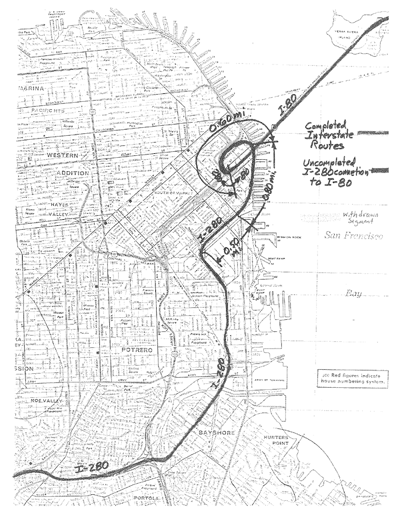
Withdrawal of I-470 -- Denver, Colorado
Description of Withdrawn Route
Interstate Route 470 was originally planned as a 26.3-mile beltway within the southwest area of metropolitan Denver.
Withdrawal Action
On July 28, 1977, Governor Richard D. Lamm submitted a request by the State of Colorado for the withdrawal of I-470 from the Interstate System.
On September 30, 1977, Federal Highway Administrator William M. Cox and Urban Mass Transportation Administrator Richard S. Page approved the withdrawal under the provisions of 23 U.S.C. 103(e)(4).
In accordance with Section 103(e)(4), Colorado's unobligated balance of Interstate Construction (IC) funds was reduced by approximately $4.0 million on the date of the withdrawal. The reduction was accomplished by decreasing Colorado's FY 1978 IC apportionment.
Withdrawal Value
The "Base" withdrawal value was based on the Federal share of the cost to complete I-470 as reported in the Interstate Cost Estimate (ICE) at the time of the withdrawal. The Base cost was adjusted quarterly to determine a new withdrawal value in accordance with Section 125 of the Federal-Aid Highway Amendments of 1974 reflecting variations in the cost of construction. The adjustment due to construction cost variances was terminated by the Surface Transportation Assistance Act of 1982. These values are shown in the following table:
| Base Cost (1977 ICE) | 160.2 million |
| Obligations for Highway Projects | 245.5 million |
| Obligations for Transit Projects | 18.4 million |
| Remaining Entitlement | 0.0 million |
| Final Withdrawal Value | 263.8 million |
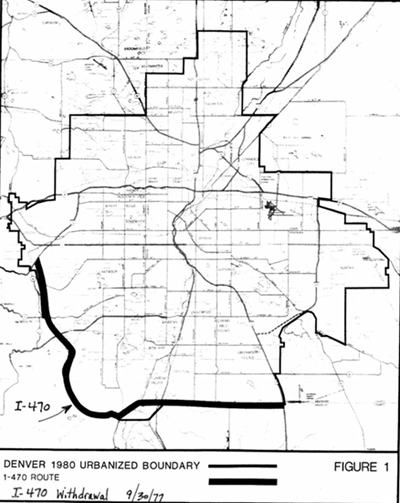
Withdrawal of I-86, 291, 491, 284 & 484 -- Hartford-New Britain, CT
Description of Withdrawn Routes
The withdrawal of five Interstate routes (I-86, I-291, I-491, I-284 and I-484) in the Hartford-New Britain area of Connecticut was accomplished in four stages.
Withdrawal Action
Stage One
On June 20, 1975, Governor Ella T. Grasso requested the withdrawal of portions of (a) 12.0 miles of I-291 between I-84 in Farmington and I-84 in Windsor, and (b) 5.9 miles of I-86 between I-91 in Wethersfield and I-84 in Manchester from the Interstate System under the provisions of 23 U.S.C. 103(e)(2) and 103(e)(4). Withdrawn mileage totalled 3.9 miles under Section 103(e)(2) and 14.0 miles under Section 103(e)(4).
On December 10, 1975, Federal Highway Administrator Norbert T. Tiemann and Urban Mass Transportation Administrator Robert E. Patricelli approved the withdrawal.
Under Section 103(e)(2) the two administrators also approved the addition to the Interstate System of (a) 3.3 miles of U.S. Route 5 between I-84 in East Hartford and I-291 in South Windsor, and (b) 6.7 miles of Connecticut Route 66 between I-84 in Cheshire and I-91 in Meriden. Route 5 eventually became known as I-284 and was later itself withdrawn from the Interstate System (See stage three below). Route 66 was eventually completed and is designated as I-691.
In accordance with Section 103(e)(4), Connecticut's unobligated balance of Interstate Construction (IC) funds was reduced by approximately $59.3 million accomplished by the reduction of the State's FY 1974 and 1975 IC apportionments.
Stage Two
On November 14, 1979, and May 19, 1980, Governor Ella T. Grasso requested the withdrawal of 8.2 miles of I-491 (old I-291) between I-84 at Farmington and I-91 at Rocky Hill from the Interstate System under the provisions of Section 103(e)4).
On August 26, 1980, Federal Highway Administrator John S. Hassell and Urban Mass Transportation Administrator Theodore C. Lutz approved the withdrawal.
In accordance with Section 103(e)(4), Connecticut's unobligated balance of IC funds was reduced by approximately $14.2 million on the date of the withdrawal. The reduction was accomplished by reducing Connecticut's FY 1979 and 1980 apportionments.
Stage Three
On March 25, 1983, Governor William A. O'Neill requested the withdrawal of I-284 between I-84 in East Hartford and I-291 in South Windsor from the Interstate System. In subsequent communications it was agreed that a 0.29-mile segment between I-284 and Governor Street was open to traffic and could not be withdrawn under Section 103(e)(4).
On September 16, 1983, Federal Highway Administrator R. A. Barnhart and Urban Mass Transportation Acting Administrator G. Kent Woodman approved the withdrawal of 3.1 miles of I-284 between Governor Street and I-291 under the provisions of Section 103(e)(4). They also approved the deletion of the 0.29-mile segment from the Interstate System under Section 103(f).
It was noted that I-284 (formerly U.S. Route 5) was the primary facility added to the Interstate System under Section 103(e)(2) in conjunction with the December 1975 withdrawal of portions of I-291 and I-86 in Hartford. Howard-Cramer Routes [103(e)(2)] designated prior to enactment of the Federal-Aid highway Act of 1976 (i.e. 5/5/76) could later be withdrawn under Section 103(e)(4).
In accordance with Section 103(e)(4), Connecticut's unobligated balance of IC funds was reduced by approximately $2.1 million on the date of the withdrawal. The reduction was accomplished by decreasing Connecticut's FY 1984 IC apportionment.
Stage Four
On March 14, 1983, Governor William A. O'Neill requested the withdrawal of 1.3 miles of I-484 between I-84 and I-91 in Hartford from the Interstate System. In subsequent communications it was agreed that the westerly 0.3-mile segment and the easterly 0.2-mile segment were open to traffic and could not be withdrawn under Section 103(e)(4).
On September 29, 1983, Federal Highway Administrator R. A. Barnhart and Urban Mass Transportation Acting Administrator G. Kent Woodman approved the withdrawal under the provisions of 23 U.S.C. 103(e)(4). The easterly and western segments totalling 0.5 miles were deleted from the Interstate System under Section 103(f).
In accordance with Section 103(e)(4), Connecticut's unobligated balance of IC funds was reduced by approximately $1.7 million on the date of the withdrawal. The reduction was accomplished by decreasing Connecticut's FY 1984 IC apportionment.
Withdrawal Value
The "Base" withdrawal value was based on the Federal share of the cost to complete the routes as reported in the Interstate Cost Estimate (ICE) at the time of the withdrawal. The Base cost was adjusted quarterly to determine a new withdrawal value in accordance with Section 125 of the Federal-Aid Highway Amendments of 1974 reflecting variations in the cost of construction. The adjustment due to construction cost variances was terminated by the Surface Transportation Assistance Act of 1982. These values are shown in the following table:
| Stage One Base Cost (1975 ICE) | 189.4 million |
| Stage Two Base Cost (1979 ICE) | 81.3 million |
| Stage Three Base Cost (1981 ICE) | 29.6 million |
| Stage Four Base Cost (1981 ICE) | 35.9 million |
| Total Base Cost | 336.2 million |
| Obligations for Highway Projects | 605.2 million |
| Obligations for Transit Projects | 49.1 million |
| Remaining Entitlement | 2.5 million |
| Final Withdrawal Value | 656.8 million |

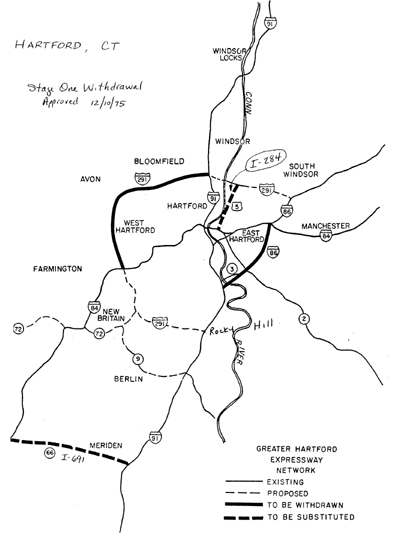
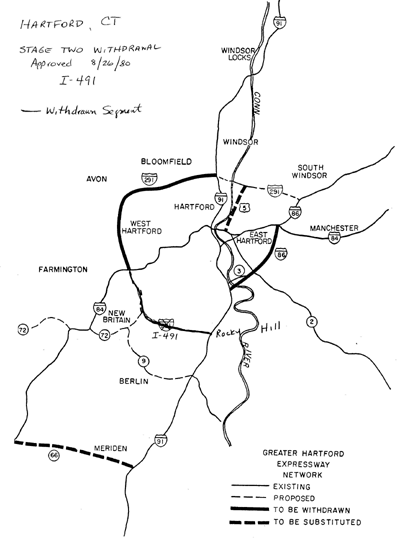
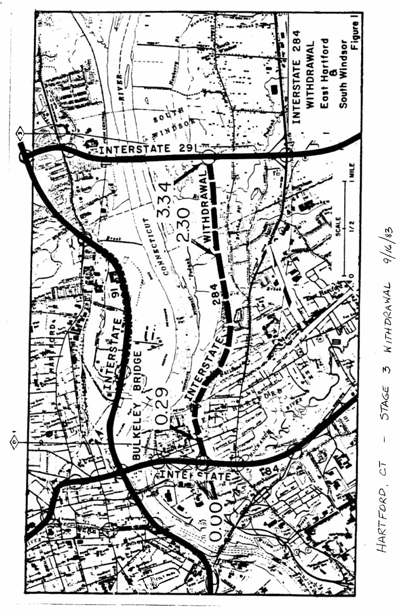
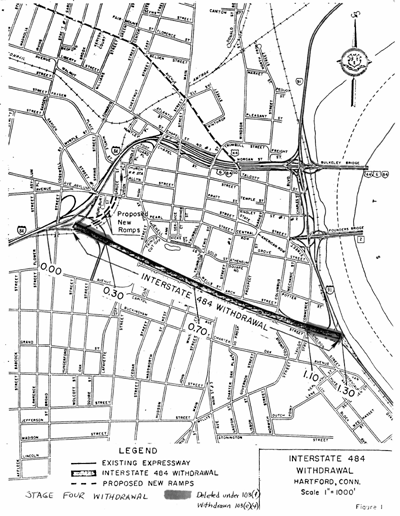
Withdrawal of I-84 -- Bolton to Killingly, Connecticut
Description of Withdrawn Route
Interstate Route 84 was originally planned to be constructed from west to east across the entire width of Connecticut serving Danbury, Waterbury, Hartford, and Killingly. The section from just east of Hartford to the New York State Line was constructed as planned. The section from east of Hartford to the Rhode Island State Line was withdrawn in two stages.
Withdrawal Action
First Stage
On July 22, 1983, Governor William A. O'Neill submitted the request by the State of Connecticut for the withdrawal of the 4.7-mile section of I-84 between Connecticut Route 52 and the Rhode Island State Line from the Interstate System.
On September 29, 1983, Federal Highway Administrator R. A. Barnhart and Urban Mass Transportation Acting Deputy Administrator G. Kent Woodman approved the withdrawal under the provisions of 23 U.S.C. 103(e)(4).
Second Stage
On August 29, 1983, Governor O'Neill submitted the request by the State of Connecticut for the withdrawal of 28.8 miles of I-84 comprised of a 11.8-mile segment between Bolton and Coventry and a 17.0-mile segment between Windham and Killingly from the Interstate System.
On September 29, 1983, Federal Highway Administrator R. A. Barnhart and Urban Mass Transportation Acting Deputy Administrator G. Kent Woodman approved the withdrawal under the provisions of 23 U.S.C. 103(e)(4). The 4.4-mile segment of I-84 between the two withdrawn segments was already constructed and opened-to-traffic and could not be withdrawn. Since it no longer connected to the remainder of the System and was deleted from the Interstate System under the provisions of 23 U.S.C. 103(f).
Route continuity for I-84 was maintained by rerouting I-84 over the Wilbur Cross Parkway to the Massachusetts Turnpike near Sturbridge, Massachusetts.
In accordance with Section 103(e)(4), Connecticut's unobligated balance of Interstate Construction (IC) funds was reduced by approximately $22.9 million on the date of the two withdrawals. The reduction was accomplished by decreasing Connecticut's FY 1984 IC apportionment.
Withdrawal Value
The "Base" withdrawal value was based on the Federal share of the cost to complete I-84 as reported in the Interstate Cost Estimate (ICE) at the time of the withdrawal. The Base cost was adjusted quarterly to determine a new withdrawal value in accordance with Section 125 of the Federal-Aid Highway Amendments of 1974 reflecting variations in the cost of construction. The adjustment due to construction cost variances was terminated by the Surface Transportation Assistance Act of 1982. These values are shown in the following table:
| Stage One Base Cost (1981 ICE) | 36.9 million |
| Stage Two Base Cost (1981 ICE) | 307.7 million |
| Obligations for Highway Projects | 349.1 million |
| Obligations for Transit Projects | 1.5 million |
| Remaining Unobligated Entitlement | 54.3 million |
| Final Withdrawal Value | 404.9 million |
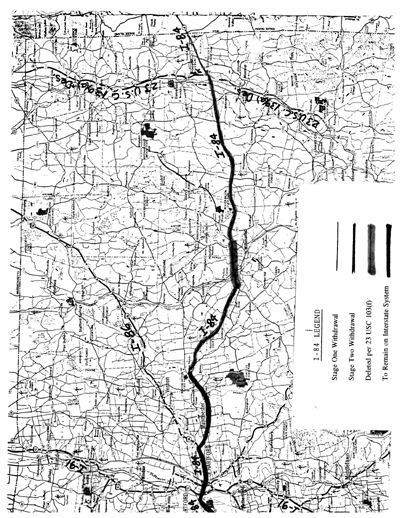
Withdrawal of I-70S, 95, 66, 266, 295, 395 & 695 -- Washington, DC
Description of Withdrawn Routes
The withdrawal of seven Interstate Routes or portions thereof (I-70S, I-95, I-66, I-266, I-295, I-395 & I-695) in Washington, DC was accomplished in six stages.
Withdrawal Action
Stage One
On June 27, 1975, Mayor Walter E. Washington requested the withdrawal of two segments from the Interstate System: (a) I-95 between I-295 and the Maryland State line and (b) all of I-70S in the district.
On October 3, 1975, Federal Highway Administrator Norbert T. Tiemann and Urban Mass Transportation Administrator Robert E. Patricelli approved the withdrawal of the two routes under the provisions of 23 U.S.C. 103(e)(4). The withdrawal removed 5.4 miles in DC from the Interstate System.
In accordance with Section 103(e)(4), DC's unobligated balance of Interstate Construction (IC) funds was increased by approximately $159.2 million to $304.3 million since the withdrawal was approved prior to the May 5, 1976, enactment of the Federal-Aid Highway Act of 1976. The increase was accomplished by increasing DC's IC apportionment for FY 1977.
Stage Two
On December 29, 1976, Mayor Walter E. Washington requested the withdrawal of two more segments from the Interstate System: (a) the portion of I-66 between I-266 and I-395, and (b) the I-266 Three Sisters Bridge over the Potomac River to the Virginia State line. The two route portions total 2.50 miles.
On April 29, 1977, Federal Highway Administrator William M. Cox and Urban Mass Transportation Acting Administrator Charles F. Bingman approved the withdrawal of the two routes under the provisions of 23 U.S.C. 103(e)(4).
In accordance with Section 103(e)(4), DC's unobligated balance of IC funds was decreased by approximately $103.5 million accomplished by decreasing DC's IC apportionment for FY 1977.
Stage Three
On August 7, 1978, Mayor Walter E. Washington requested the withdrawal of portions of the East leg and North Leg Freeways (I-295 and I-395).
On September 8, 1978, Federal Highway Administrator Karl S. Bowers and Urban Mass Transportation Administrator Richard S. Page approved the withdrawal under the provisions of 23 U.S.C. 103(e)(4). The two route portions total 4.70 miles.
In accordance with Section 103(e)(4), DC's unobligated balance of IC funds was decreased by approximately $130.1 million accomplished by decreasing DC's IC apportionment for FY 1977.
Stage Four
On April 30, 1980, Mayor Marion S. Barry requested the withdrawal of a 1.7-mile segment of the South Leg Freeway portion of I-695 between I-66 and I-395.
On August 27, 1980, Federal Highway Administrator John S. Hassell and Urban Mass Transportation Deputy Administrator Lillian C. Liburdi approved the withdrawal under the provisions of 23 U.S.C. 103(e)(4). In addition a 0.12 mile segment of I-695 was deleted from the Interstate System under Section 103(f).
In accordance with Section 103(e)(4), DC's unobligated balance of IC funds was decreased by approximately $45.9 million accomplished by decreasing DC's IC apportionment for FY 1980.
Stage Five
On January 27, 1982, Mayor Marion S. Barry requested the withdrawal of the westerly 0.6-mile segment of I-266 between the Three Sisters terminus and Key Bridge.
On June 28, 1982, Federal Highway Administrator R. A. Barnhart and Urban Mass Transportation Administrator Arthur E. Teele approved the withdrawal under the provisions of 23 U.S.C. 103(e)(4).
In accordance with Section 103(e)(4), DC's unobligated balance of IC funds was decreased by approximately $10.8 million accomplished by decreasing DC's IC apportionment for FY 1982 and 1983.
Stage Six
On May 19, 1983, Mayor Marion S. Barry requested the withdrawal of (a) the remaining 0.51-mile segment of I-266 and (b) a 0.25-mile segment of I-66 within the I-66/I-266 interchange area.
On August 19, 1983, Federal Highway Administrator R. A. Barnhart and Urban Mass Transportation Acting Administrator G. Kent Woodman approved the withdrawals under the provisions of 23 U.S.C. 103(e)(4).
In accordance with Section 103(e)(4), DC's unobligated balance of IC funds was decreased by approximately $12.9 million accomplished by decreasing DC's IC apportionment for FY 1983.
Withdrawal Value
The "Base" withdrawal value was based on the Federal share of the cost to complete these Interstate routes as reported in the Interstate Cost Estimate (ICE) at the time of the withdrawal. The Base cost was adjusted quarterly to determine a new withdrawal value in accordance with Section 125 of the Federal-Aid Highway Amendments of 1974 reflecting variations in the cost of construction. The adjustment due to construction cost variances was terminated by the Surface Transportation Assistance Act of 1982. These values are shown in the following table:
| Stage One Base Cost (1975 ICE) | 304.3 million |
| Stage Two Base Cost (1975 ICE) | 300.6 million |
| Stage Three Base Cost (1977 ICE) | 403.5 million |
| Stage Four Base Cost (1979 ICE) | 230.4 million |
| Stage Five Base Cost (1981 ICE) | 110.2 million |
| Stage Six Base Cost (1981 ICE) | 121.8 million |
| Obligations for Highway Projects | 233.4 million |
| Obligations for Transit Projects | 1,963.5 million |
| Remaining Entitlement | 0.8 million |
| Final Withdrawal Value | 2,197.7 million |
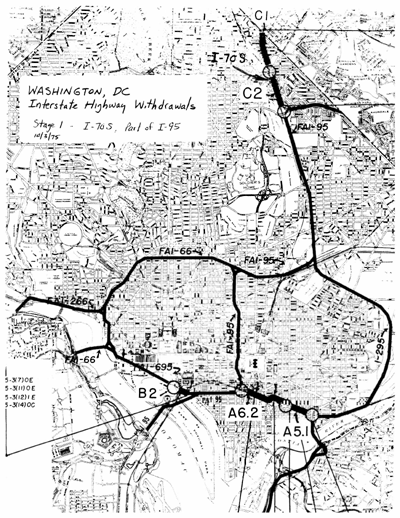
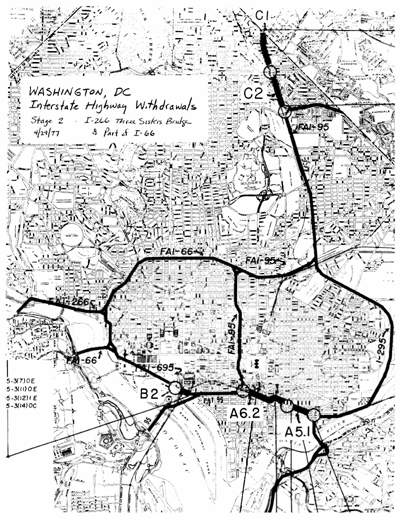
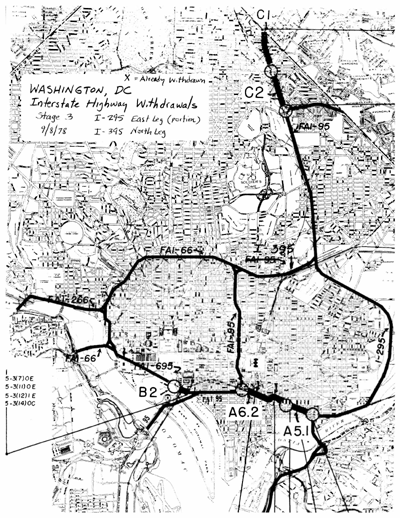
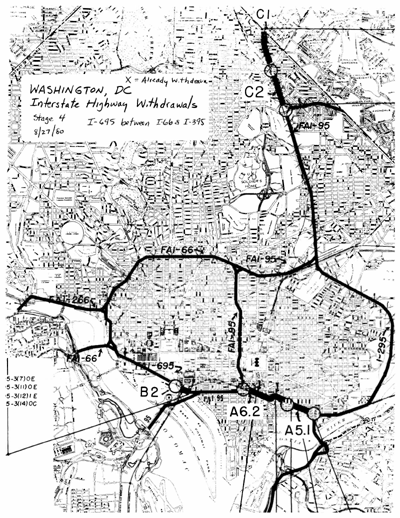
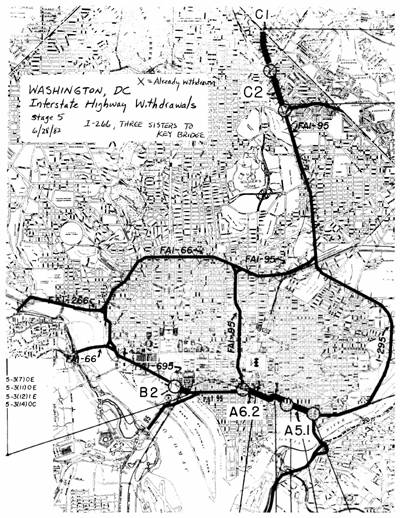
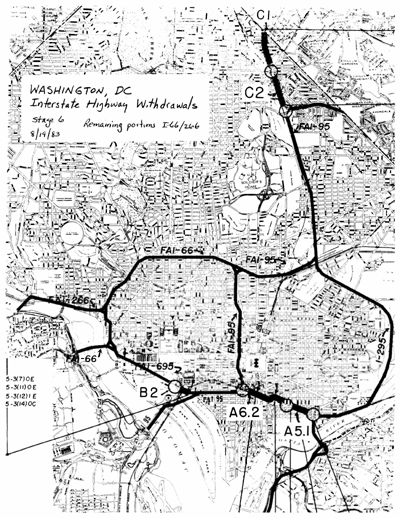
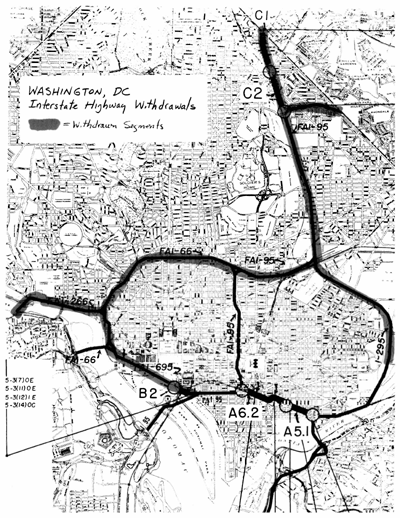
Withdrawal of I-420 -- Atlanta, Georgia
Description of Withdrawn Route
Interstate Route 420 was originally planned as a 6.0-mile connection between I-75 in Atlanta and I-20 in DeKalb County.
Withdrawal Action
On August 11, 1983, Governor Joe Frank Harris requested the withdrawal of I-420 from the Interstate System.
On September 29, 1983, Federal Highway Administrator R. A. Barnhart and Urban Mass Transportation Acting Deputy Administrator G. Kent Woodman approved the withdrawal of the easterly 5.4 miles under the provisions of 23 U.S.C. 103(e)(4) subject to receipt of additional information clarifying the support for the withdrawal from the local governments concerned. The remaining 0.6 miles was already constructed and open to traffic and was removed from the System under Section 103(f).
Following receipt of an August 16, 1984, letter from Governor Harris and other information received since September 1983, the Administrators removed the conditions contained in their 1983 letter.
In accordance with Section 103(e)(4), Georgia's unobligated balance of Interstate Construction (IC) funds was reduced by approximately $2,873 on the date of the withdrawal. The reduction was accomplished by decreasing Georgia's unobligated balance of Interstate Gap funds.
Georgia Route 400
On of the substitute projects included in the concept plan by the State was construction of the North Atlanta Parkway, GA 400, a radial into Atlanta from the I-285 Perimeter due north of the Atlanta CBD. The GA 400 project became very controversial and a suit was filed in the U.S. District Court for Washington, DC to stop GA 400. On 7/25/86 the court ruled in favor of the defendants (U.S. DOT, et al). GA 400 was eventually built as a toll road without participation of Federal-Aid funds.
Withdrawal Value
The "Base" withdrawal value was based on the Federal share of the cost to complete I-420 as reported in the Interstate Cost Estimate (ICE) at the time of the withdrawal. The Base cost was adjusted quarterly to determine a new withdrawal value in accordance with Section 125 of the Federal-Aid Highway Amendments of 1974 reflecting variations in the cost of construction. The adjustment due to construction cost variances was terminated by the Surface Transportation Assistance Act of 1982. These values are shown in the following table:
| Base Cost (1981 ICE) | 96.4 million |
| Obligations for Highway Projects | 111.9 million |
| Obligations for Transit Projects | 0.0 million |
| Remaining Entitlement | 0.6 million |
| Final Withdrawal Value | 112.6 million |
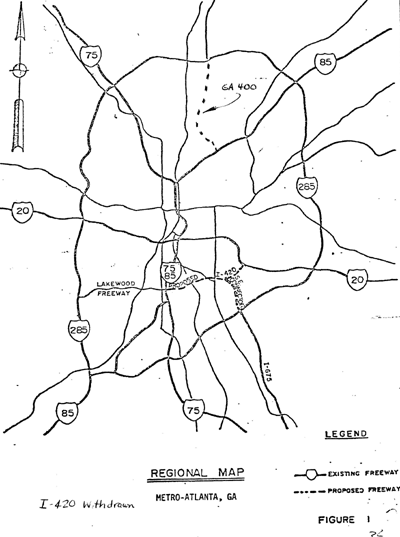
Withdrawal of I-494 -- Chicago, Illinois
Description of Withdrawn Route
Interstate Route 494 was originally planned along a 19.9-mile alignment as the north-south Chicago Crosstown Expressway connecting the Dan Ryan Expressway (I-94) on the south with the Kennedy (I-90) and Edens (I-94) Expressways on the north.
Withdrawal Action
The entire Crosstown Expressway was withdrawn in two stages.
Stage One
On May 19, 1977, Governor James R. Thompson and Mayor Michael A. Bilandic submitted a joint request by the State of Illinois and the City of Chicago for the withdrawal of a 6.3-mile portion of I-494 between the Eisenhower Expressway (I-290) and the Kennedy-Edens (I-90/94) Expressways from the Interstate System.
On September 30, 1977, Federal Highway Administrator William M. Cox and Urban Mass Transportation Administrator Richard S. Page approved the withdrawal under the provisions of 23 U.S.C. 103(e)(4).
In accordance with Section 103(e)(4), Illinois's unobligated balance of Interstate Construction (IC) funds was reduced by approximately $89.4 million on the date of the withdrawal. The reduction was accomplished by decreasing Illinois's IC apportionment for FY 1976.
Stage Two
On September 26, 1979, Governor James R. Thompson and Mayor Jane Byrne submitted a joint request by the State of Illinois and the City of Chicago for the withdrawal of the remaining 13.6-mile portion of I-494 between the Dan Ryan (I-94) and Eisenhower (I-290) Expressways from the Interstate System.
On October 1, 1977, Deputy Federal Highway Administrator John S. Hassell and Urban Mass Transportation Acting Administrator Lillian C. Liburdi approved the withdrawal under the provisions of 23 U.S.C. 103(e)(4).
In accordance with Section 103(e)(4), Illinois's unobligated balance of IC funds was reduced by approximately $67.2 million on the date of the withdrawal. The reduction was accomplished by decreasing Illinois's IC apportionment for FY 1980.
Withdrawal Value
The "Base" withdrawal value was based on the Federal share of the cost to complete I-494 as reported in the Interstate Cost Estimate (ICE) at the time of the withdrawal. The Base cost was adjusted quarterly to determine a new withdrawal value in accordance with Section 125 of the Federal-Aid Highway Amendments of 1974 reflecting variations in the cost of construction. The adjustment due to construction cost variances was terminated by the Surface Transportation Assistance Act of 1982. These values are shown in the following table:
| Base Cost (1977 ICE) | 453.1 million |
| Base Cost (1977 ICE) | 1,011.3 million |
| Obligations for Highway Projects | 1,692.1 million |
| Obligations for Transit Projects | 879.5 million |
| Remaining Entitlement | 5.3 million |
| Final Withdrawal Value | 2,576.9 million |
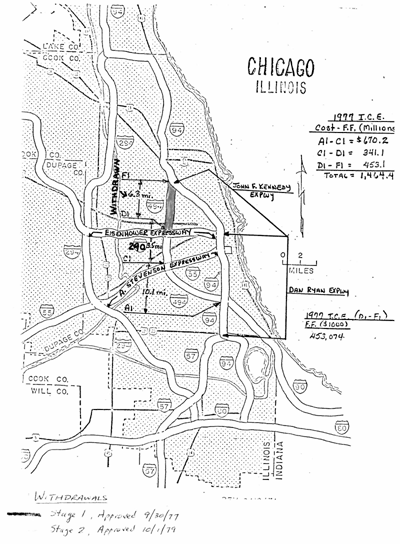
Withdrawal of I-165 -- Indianapolis, Indiana
Description of Withdrawn Route
Interstate Route 165 was originally planned as a 2.7-mile spur route between I-65 and 38th Street in Indianapolis.
Withdrawal Action
On April 16, 1981, Governor Robert D. Orr and Mayor William H. Hudnut submitted a joint request by the State of Indiana and the City of Indianapolis for the withdrawal of I-165 from the Interstate System.
On July 30, 1981, Federal Highway Administrator R. A. Barnhart and Urban Mass Transportation Administrator Arthur E. Teele approved the withdrawal under the provisions of 23 U.S.C. 103(e)(4).
In accordance with Section 103(e)(4), Indiana's unobligated balance of Interstate Construction (IC) funds was reduced by approximately $3.1 million on the date of the withdrawal. The reduction was accomplished by decreasing Indiana's IC apportionment for FY 1982.
Withdrawal Value
The "Base" withdrawal value was based on the Federal share of the cost to complete I-165 as reported in the Interstate Cost Estimate (ICE) at the time of the withdrawal. The Base cost was adjusted quarterly to determine a new withdrawal value in accordance with Section 125 of the Federal-Aid Highway Amendments of 1974 reflecting variations in the cost of construction. The adjustment due to construction cost variances was terminated by the Surface Transportation Assistance Act of 1982. These values are shown in the following table:
| Base Cost (1979 ICE) | 52.6 million |
| Obligations for Highway Projects | 72.5 million |
| Obligations for Transit Projects | 14.5 million |
| Remaining Entitlement | 0.6 million |
| Final Withdrawal Value | 87.6 million |
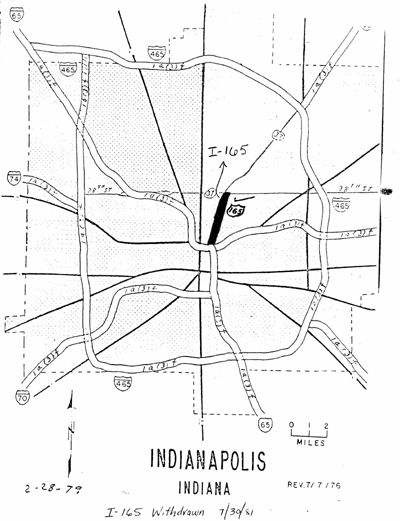
Withdrawal of I-380 -- Waterloo, Iowa
Description of Withdrawn Route
Interstate Route 380 was originally planned as a 80-mile spur from I-80 at Iowa City to Waterloo.
Withdrawal Action
On September 18, 1981, Governor Robert D. Ray requested the withdrawal from the Interstate System of a 7.3-mile portion of I-380 at its northern terminus at Waterloo.
On November 25, 1981, Federal Highway Administrator R. A. Barnhart and Urban Mass Transportation Administrator Arthur E. Teele approved the withdrawal under the provisions of 23 U.S.C. 103(e)(4).
In accordance with Section 103(e)(4), Iowa's unobligated balance of Interstate Construction (IC) funds was reduced by approximately $0.7 million on the date of the withdrawal. The reduction was accomplished by reducing Iowa's IC apportionment for FY 1982.
Withdrawal Value
The "Base" withdrawal value was based on the Federal share of the cost to complete I-380 as reported in the Interstate Cost Estimate (ICE) at the time of the withdrawal. The Base cost was adjusted quarterly to determine a new withdrawal value in accordance with Section 125 of the Federal-Aid Highway Amendments of 1974 reflecting variations in the cost of construction. The adjustment due to construction cost variances was terminated by the Surface Transportation Assistance Act of 1982. These values are shown in the following table:
| Base Cost (1979 ICE) | 189.2 million |
| Obligations for Highway Projects | 313.5 million |
| Obligations for Transit Projects | 2.0 million |
| Remaining Entitlement | 0.2 million |
| Final Withdrawal Value | 315.7 million |
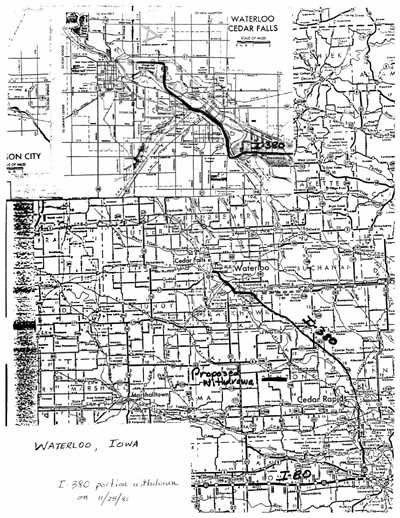
Withdrawal of I-95 and I-695 -- Boston, Massachusetts
Description of Withdrawn Routes
Interstate Route 95 was originally planned to past through Massachusetts on a north-south alignment that took it through the middle of downtown Boston. I-695 was envisioned as a short inner belt near downtown Boston connecting I-93 and I-95. The withdrawal of these two route segments was the first Interstate withdrawal action approved under 23 U.S.C. 103(e)(4).
Withdrawal Action
On March 26, 1974, Governor Francis W. Sargent submitted comprehensive transportation proposals for the Greater Boston region and requested the withdrawal of the entire I-695 Inner Loop and most of I-95 within the Route 128 belt and certain other system modifications in Greater Boston.
On May 23, 1974, Federal Highway Administrator Norbert T. Tiemann and Urban Mass Transportation Administrator Frank C. Herringer approved the withdrawal under the provisions of 23 U.S.C. 103(e)(2) and 103(e)(4). In addition to the withdrawals, two substitute Interstate segments were approved under 103(e)(2) - a 1.4-mile segment of the Southeast Expressway as I-93, and an extension of I-495, the Boston outer belt, in Bristol County. In order to provide system continuity, other segments were added to the System under 23 U.S.C. 139(a). These 139(a) additions were the Route 128 belt as I-95; extension of the Massachusetts Turnpike eastward to the Southeast Expressway as I-90; extension of Route 128 to connect to the Southeast Expressway; and a further extension of I-495 in Bristol County. Finally, the action provided that the remaining portion of I-95 not withdrawn by this action, namely a connection across Boston Harbor to Logan Airport would be realigned to provide a special purpose I-90 tunnel spur under the Inner Harbor to Logan Airport. This final action, as later modified by Section 138 of the 1987 STURAA (P.L. 100-17), led to the eventual construction of the I-90 Third Harbor Tunnel, a four-lane facility which has been named as the Ted Williams Tunnel, in honor of the Boston Red Sox Hall of Famer.
Massachusetts Governor Dukakis in a July 27, 1983, letter to Secretary Dole asked for further modifications to the Interstate System in Boston. In her September 29 approval letter, Secretary Dole approved the following: (1) the withdrawal of 1.4 miles of the Southeast Expressway previously added to the System in 1974 as a substitute Howard-Cramer facility under 103(e)(2), and (2) the designation of the Southeast Expressway from Braintree northerly to the Central Artery under the provisions of Section 139(a). As a result of this action and in accordance with Section 103(e)(4), Massachusetts's unobligated balance of Interstate Construction (IC) funds was reduced by approximately $12.7 million on the date of the withdrawal. The reduction was accomplished by decreasing Massachusetts' IC apportionment for FY 1983.
Withdrawal Value
The "Base" withdrawal value was based on the Federal share of the cost to complete I-95 and I-695 as reported in the Interstate Cost Estimate (ICE) at the time of the withdrawal. The Base cost was adjusted quarterly to determine a new withdrawal value in accordance with Section 125 of the Federal-Aid Highway Amendments of 1974 reflecting variations in the cost of construction. The adjustment due to construction cost variances was terminated by the Surface Transportation Assistance Act of 1982. These values are shown in the following table:
| Base Cost (1972 ICE) | 637.7 million |
| Obligations for Highway Projects | 86.6 million |
| Obligations for Transit Projects | 1,451.4 million |
| Remaining Entitlement | 0.1 million |
| Final Withdrawal Value | 1,538.0 million |
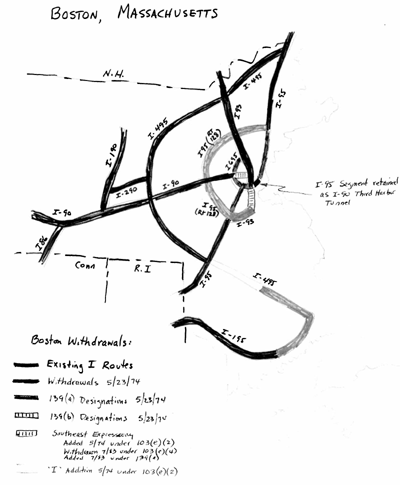
Withdrawal of I-895 -- Fall River to Providence, Massachusetts
Description of Withdrawn Route
Interstate Route 895 was originally planned to extend from I-95 northeast of the Connecticut-Rhode Island State line easterly to Newport, RI, then northerly to I-195 just west of Fall River, MA. The portion in Rhode Island was not constructed and was removed from the Interstate System on May 20, 1983. The portion of I-895 in Massachusetts totalled 1.5 miles.
Withdrawal Action
On January 8, 1982, Governor Edward J. King requested the withdrawal of I-895 in Massachusetts from the Interstate System.
On October 15, 1982, Federal Highway Administrator R. A. Barnhart and Urban Mass Transportation Administrator Arthur E. Teele approved the withdrawal under the provisions of 23 U.S.C. 103(e)(4).
In accordance with Section 103(e)(4), Massachusetts's unobligated balance of Interstate Construction (IC) funds was reduced by approximately $1.1 million on the date of the withdrawal. The reduction was accomplished by reducing Massachusetts's IC apportionment for FY 1983.
Withdrawal Value
The "Base" withdrawal value was based on the Federal share of the cost to complete I-895 as reported in the Interstate Cost Estimate (ICE) at the time of the withdrawal. The Base cost was adjusted quarterly to determine a new withdrawal value in accordance with Section 125 of the Federal-Aid Highway Amendments of 1974 reflecting variations in the cost of construction. The adjustment due to construction cost variances was terminated by the Surface Transportation Assistance Act of 1982. These values are shown in the following table:
| Base Cost (1981 ICE) | 12.2 million |
| Obligations for Highway Projects | 13.5 million |
| Obligations for Transit Projects | 0.5 million |
| Remaining Entitlement | 0.3 million |
| Final Withdrawal Value | 14.3 million |
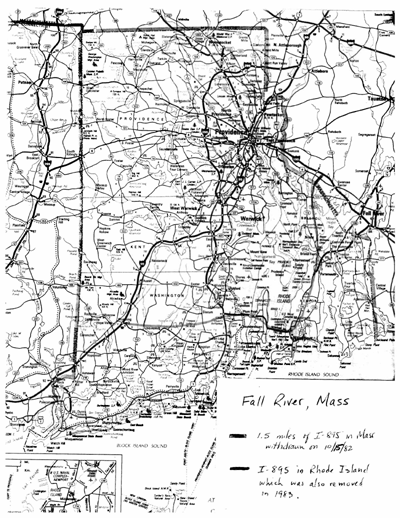
Withdrawal of I-70S -- Maryland Suburbs of Washington, DC
Description of Withdrawn Route
Interstate Route 70 was planned and constructed to extend east-west across the nation from central Utah to Maryland. As originally planned I-70 near its eastern terminus would split at Frederick, Maryland, with I-70N continuing to its terminus in Baltimore and I-70S continuing to its terminus in Washington, DC. Most of the portion of I-70N within the Baltimore Beltway was not constructed and was withdrawn. Similarly, the portion within the Capital Beltway at Washington was also not constructed and withdrawn. Eventually the cardinal direction portion of the route number was removed and the Baltimore leg was renumbered as I-70 and the Washington leg as I-270.
Withdrawal Action
On February 25, 1975, Governor Marvin Mandel requested the withdrawal from the Interstate System of the 3.4 mile portion of I-70S within the Capital Beltway between the beltway and the DC line.
On July 28, 1975, Federal Highway Administrator Norbert T. Tiemann and Urban Mass Transportation Acting Administrator Judith T. Connor approved the withdrawal of 1.8 miles under the provisions of 23 U.S.C. 103(e)(4), and 1.6 miles under 103(e)(2).
In accordance with Section 103(e)(4), Maryland's unobligated balance of Interstate Construction (IC) funds was reduced by approximately $20.8 million on the date of the withdrawal. The reduction was accomplished by reducing Maryland's IC apportionment for FY 1974 and 1975.
Withdrawal Value
The "Base" withdrawal value was based on the Federal share of the cost to complete I-70S as reported in the Interstate Cost Estimate (ICE) at the time of the withdrawal. The Base cost was adjusted quarterly to determine a new withdrawal value in accordance with Section 125 of the Federal-Aid Highway Amendments of 1974 reflecting variations in the cost of construction. The adjustment due to construction cost variances was terminated by the Surface Transportation Assistance Act of 1982. These values are shown in the following table:
| Base Cost (1975 ICE) | 77.2 million |
| Obligations for Highway Projects | 8.1 million |
| Obligations for Transit Projects | 146.2 million |
| Remaining Entitlement | 0.2 million |
| Final Withdrawal Value | 154.4 million |
Withdrawal of I-70, I-83 & I-595 -- Baltimore, Maryland
Description of Withdrawn Route
The withdrawals of Interstate Routes 70, I-83, and I-595 in Baltimore were accomplished in two stages.
Withdrawal Action
Stage One
On July 28, 1981, Governor Harry Hughes and Mayor William D. Schaefer submitted a joint request by the State of Maryland and the City of Baltimore for the withdrawal of a portion of I-70 inside the Baltimore Beltway from the Interstate System.
On September 3, 1981, Federal Highway Administrator R. A. Barnhart and Urban Mass Transportation Administrator Arthur E. Teele approved the withdrawal under the provisions of 23 U.S.C. 103(e)(4). The withdrawn segment extended for 3.3 miles from Security Boulevard to I-170 and would have impacted Leaken Park. The portion of I-70 from the I-695 Baltimore Beltway to Security Boulevard was already constructed at the time of this withdrawal and remains on the System as I-70.
As a result of this withdrawal, an unbuilt section of I-70 from I-170 to I-95 remained on the Interstate System. This section, along with I-170, were eventually renumbered as I-595, and in Stage Two were also withdrawn from the Interstate System.
Stage Two
On July 22, 1983, Governor Hughes and Mayor Schaefer submitted a joint request by the State of Maryland and the City of Baltimore for the withdrawal of all of I-595 and a portion of I-83 from the Interstate System.
On September 29, 1983, Federal Highway Administrator R. A. Barnhart and Urban Mass Transportation Acting Administrator G. Kent Woodman approved the withdrawal under the provisions of 23 U.S.C. 103(e)(4).
I-595 had been established following the Stage One withdrawal described above and consisted of (1) 2.22 miles that was formerly I-70 between I-170 and I-95 and (2) all of former I-170 (3.35 miles in length). The 2.22 mile segment was withdrawn under 103(e)(4) and the I-170 section which had been completed and open to traffic for a number of years was deleted from the System under 103(f).
The withdrawn portion of I-83 was 3.35 miles long and extended from its southern terminus at I-95 to Fayette Street near downtown Baltimore.
Withdrawal Value
The "Base" withdrawal value was based on the Federal share of the cost to complete the three routes as reported in the Interstate Cost Estimate (ICE) at the time of the withdrawal. The Base cost was adjusted quarterly to determine a new withdrawal value in accordance with Section 125 of the Federal-Aid Highway Amendments of 1974 reflecting variations in the cost of construction. The adjustment due to construction cost variances was terminated by the Surface Transportation Assistance Act of 1982. These values are shown in the following table:
| Stage One Base Cost (1979 ICE) | 129.5 million |
| Stage Two Base Cost (1981 ICE) | 738.9 million |
| Obligations for Highway Projects | 575.3 million |
| Obligations for Transit Projects | 460.4 million |
| Remaining Entitlement | 12.0 million |
| Final Withdrawal Value | 1,047.7 million |
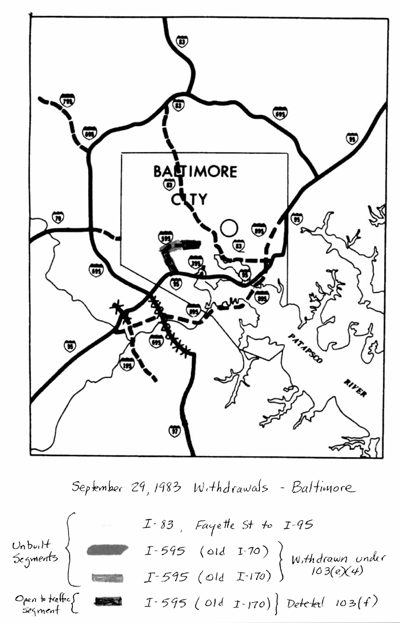
Withdrawal of I-297 -- Bowie to Millersville, Maryland
Description of Withdrawn Route
Interstate Route 297 was originally added to the Interstate System on July 28, 1975, as a "Howard-Cramer" addition under the provisions of 23 U.S.C. 104(e)(2). I-297 extends along a 8.91-mile alignment between U.S. 50 (then I-68) at Bowie and I-97 at Millersville, Maryland.
Withdrawal Action
On July 22, 1983, Governor Harry Hughes submitted a joint request by the State of Maryland and the Counties of Anne Arundel and Prince Georges for the withdrawal of I-297 from the Interstate System.
On September 29, 1983, Federal Highway Administrator R. A. Barnhart and Urban Mass Transportation Acting Deputy Administrator G. Kent Woodman approved the withdrawal under the provisions of 23 U.S.C. 103(e)(4).
Withdrawal Value
The "Base" withdrawal value was based on the Federal share of the cost to complete I-297 as reported in the Interstate Cost Estimate (ICE) at the time of the withdrawal. The Base cost was adjusted quarterly to determine a new withdrawal value in accordance with Section 125 of the Federal-Aid Highway Amendments of 1974 reflecting variations in the cost of construction. The adjustment due to construction cost variances was terminated by the Surface Transportation Assistance Act of 1982. These values are shown in the following table:
| Base Cost (1981 ICE) | 80.0 million |
| Obligations for Highway Projects | 93.2 million |
| Obligations for Transit Projects | 0.0 million |
| Remaining Entitlement | 0.6 million |
| Final Withdrawal Value | 93.8 million |
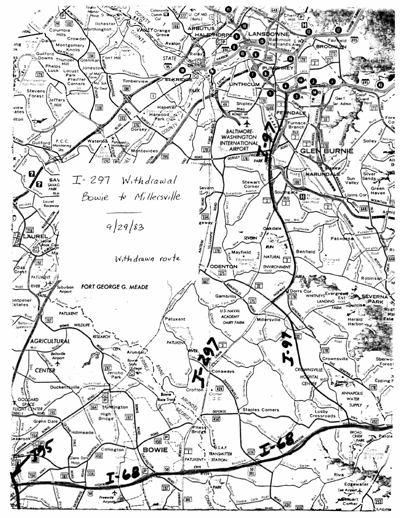
Withdrawal of I-335 -- Minneapolis - St Paul, Minnesota
Description of Withdrawn Route
Interstate Route 335 was originally intended as a 2.7-mile bypass for the central business district connecting I-94 in Minneapolis with I-35W in St. Paul.
Withdrawal Action
On March 1, 1978, Governor Rudy Perpich requested the withdrawal of all of I-335 in Minneapolis and St. Paul from the Interstate System.
On July 28, 1978, Acting Federal Highway Administrator Karl S. Bowers and Urban Mass Transportation Administrator Richard S. Page approved the withdrawal under the provisions of 23 U.S.C. 103(e)(4).
In accordance with Section 103(e)(4), Minnesota's unobligated balance of Interstate Construction (IC) funds was reduced by approximately $13.9 million on the date of the withdrawal. The reduction was accomplished by reducing Minnesota's IC apportionment for FY 1977.
Withdrawal Value
The "Base" withdrawal value was based on the Federal share of the cost to complete I-335 as reported in the Interstate Cost Estimate (ICE) at the time of the withdrawal. The Base cost was adjusted quarterly to determine a new withdrawal value in accordance with Section 125 of the Federal-Aid Highway Amendments of 1974 reflecting variations in the cost of construction. The adjustment due to construction cost variances was terminated by the Surface Transportation Assistance Act of 1982. These values are shown in the following table:
| Base Cost (1977 ICE) | 71.2 million |
| Obligations for Highway Projects | 119.1 million |
| Obligations for Transit Projects | 2.9 million |
| Remaining Entitlement | 0.0 million |
| Final Withdrawal Value | 122.0 million |
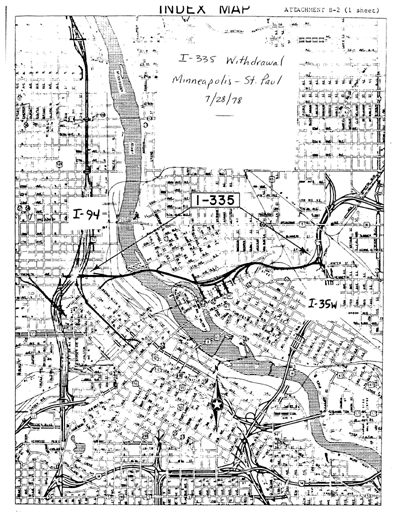
Withdrawal of I-35 -- Duluth, Minnesota
Description of Withdrawn Route
The northern terminus of Interstate Route 35 was originally planned at 68th Avenue East in Duluth, Minnesota.
Withdrawal Action
On January 27, 1981, Governor Albert H. Quie requested the withdrawal of a 4.11 mile portion of I-35 from the Interstate System.
On March 16, 1981, Federal Highway Administrator R. A. Barnhart and Urban Mass Transportation Acting Administrator Robert H. McManus approved the withdrawal under the provisions of 23 U.S.C. 103(e)(4).
The withdrawal shortened I-35, by moving the northern terminus of the route to 26th Avenue East.
In accordance with Section 103(e)(4), Minnesota's unobligated balance of Interstate Construction (IC) funds was reduced by approximately $2.2 million on the date of the withdrawal. The reduction was accomplished by reducing Minnesota's FY 1982 IC apportionment.
Withdrawal Value
The "Base" withdrawal value was based on the Federal share of the cost to complete I-35 as reported in the Interstate Cost Estimate (ICE) at the time of the withdrawal. The Base cost was adjusted quarterly to determine a new withdrawal value in accordance with Section 125 of the Federal-Aid Highway Amendments of 1974 reflecting variations in the cost of construction. The adjustment due to construction cost variances was terminated by the Surface Transportation Assistance Act of 1982. These values are shown in the following table:
| Base Cost (1979 ICE) | 44.7 million |
| Obligations for Highway Projects | 68.2 million |
| Obligations for Transit Projects | 6.3 million |
| Remaining Entitlement | 0.0 million |
| Final Withdrawal Value | 74.5 million |
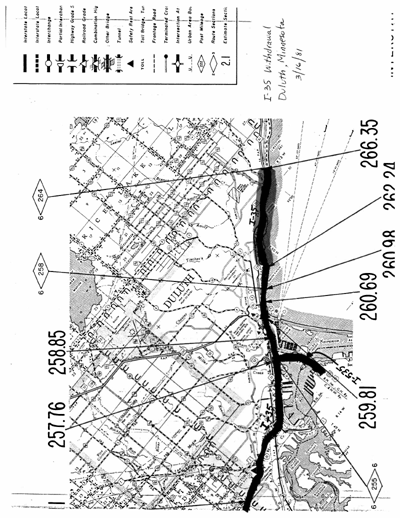
Withdrawal of I-580 -- Omaha, Nebraska
Description of Withdrawn Route
Interstate Route 580 was originally planned as a 3.22-mile spur to provide access to the Omaha regional airport through a connection with the proposed Storz Expressway. However, the City was not able to provide financing for the Storz Expressway. The withdrawal permitted the city to construct a lesser facility in place of I-580 and have funds left to construct the Storz Expressway.
The southerly 1.31 miles (connecting to I-480) was open to traffic and added to the Interstate System under 23 U.S.C. 139(a). The remaining 1.91 miles was added to the system under 103(e)(1) in December 1975 using mileage available from other withdrawals.
Withdrawal Action
On July 26, 1979, Governor Charles Thone and Mayor Al Veys submitted a joint request by the State of Nebraska and the City of Omaha for the withdrawal of I-580 from the Interstate System.
On December 14, 1979, Federal Highway Administrator Karl S. Bowers and Urban Mass Transportation Acting Administrator Lillian C. Liburdi approved the withdrawal under the provisions of 23 U.S.C. 103(e)(4) and also removed from the System the portion designated under 139(a).
On the date of the withdrawal, Nebraska's unobligated balance of Interstate Construction (IC) funds was zero, so no adjustment was necessary as normally called for by Section 103(e)(4).
Withdrawal Value
The "Base" withdrawal value was based on the Federal share of the cost to complete I-580 as reported in the Interstate Cost Estimate (ICE) at the time of the withdrawal. The Base cost was adjusted quarterly to determine a new withdrawal value in accordance with Section 125 of the Federal-Aid Highway Amendments of 1974 reflecting variations in the cost of construction. The adjustment due to construction cost variances was terminated by the Surface Transportation Assistance Act of 1982. These values are shown in the following table:
| Base Cost (1979 ICE) | 47.0 million |
| Obligations for Highway Projects | 76.3 million |
| Obligations for Transit Projects | 2.0 million |
| Remaining Entitlement | 0.0 million |
| Final Withdrawal Value | 78.3 million |
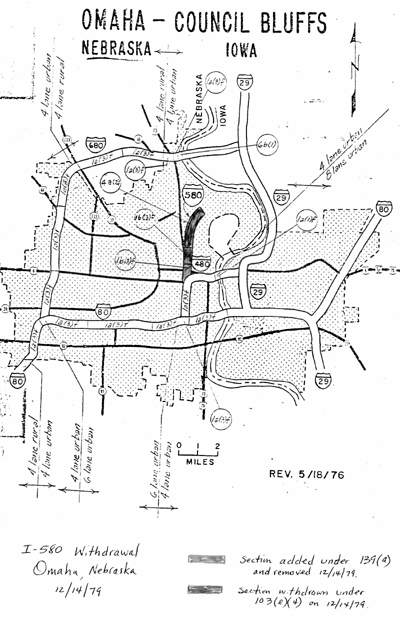
Withdrawal of I-495 and I-95 in New Jersey Within the New York City Urbanized Area
Description of Withdrawn Route
Portions of I-495 and I-95 in New Jersey within the New York City urbanized area were withdrawn in two separate action.
Withdrawal Action
Stage One
I-495 in New Jersey extended for 3.6 miles from the junction of I-95 near Secaucus easterly to the New York State Line inside the Lincoln Tunnel. Originally the Interstate travelled way was achieved by the renumbering of NJ Route 3, a limited access highway providing the principal approach to the Lincoln Tunnel. The tunnel like I-495 provided 3 through lanes in each direction and the tunnel authority indicated they had no plans for future tunnel tubes. On February 13, 1979, Governor Brendan T. Byrne requested the withdrawal of I-495 from the Interstate System. In a May 3, 1979, letter NJ Commissioner of Transportation modified the request to not include the Lincoln Tunnel portion thereby eliminating the need for coordination of the request with New York.
On September 14, 1979, Federal Highway Administrator Karl S. Bowers and Urban Mass Transportation Acting Administrator Lillian C. Liburdi approved the withdrawal of 2.1 miles from I-95 to the Pleasant-Park Avenue interchange under the provisions of 23 U.S.C. 103(e)(4).
In accordance with Section 103(e)(4), New Jersey's unobligated balance of Interstate Construction (IC) funds was reduced by approximately $3.2 million on the date of the withdrawal. The reduction was accomplished by decreasing New Jersey's IC apportionment for FY 1979.
Stage Two
A 9.7-mile portion of I-95 in the Franklin, Piscataway, and South Plainfield Townships provided to be non-viable because of community and environmental impacts. On December 10, 1980, Governor Brendan T. Byrne requested the withdrawal of this portion of I-95, from the Interstate System.
On January 19, 1981, Federal Highway Administrator John S. Hassell and Urban Mass Transportation Administrator Theodore C. Lutz approved the withdrawal under the provisions of 23 U.S.C. 103(e)(4).
Route continuity for I-95 was maintained by routing I-95 over proposed route I-695 to I-287.
In accordance with Section 103(e)(4), New Jersey's unobligated balance of Interstate Construction (IC) funds was reduced by approximately $12.5 million on the date of the withdrawal. The reduction was accomplished by decreasing New Jersey's IC apportionment for FY 1981.
Withdrawal Value
The "Base" withdrawal value was based on the Federal share of the cost to complete I-495 and I-95 as reported in the Interstate Cost Estimate (ICE) at the time of the withdrawal. The Base cost was adjusted quarterly to determine a new withdrawal value in accordance with Section 125 of the Federal-Aid Highway Amendments of 1974 reflecting variations in the cost of construction. The adjustment due to construction cost variances was terminated by the Surface Transportation Assistance Act of 1982. These values are shown in the following table:
| Stage One Base Cost (1977 ICE) | 35.7 million |
| Stage Two Base Cost (1979 ICE) | 73.0 million |
| Obligations for Highway Projects | 88.3 million |
| Obligations for Transit Projects | 95.1 million |
| Remaining Entitlement | 1.1 million |
| Final Withdrawal Value | 184.6 million |
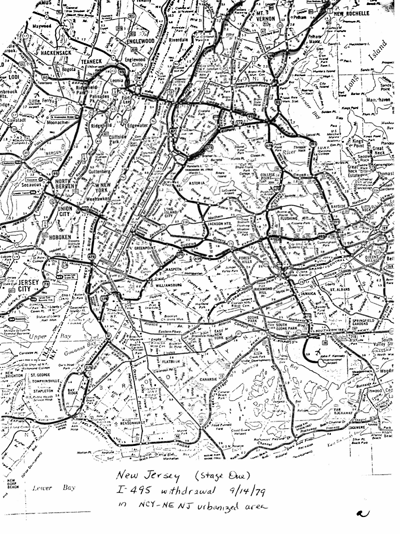
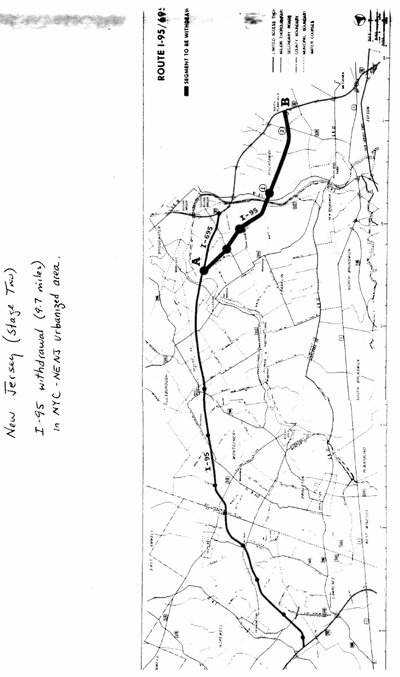
Withdrawal of I-895 in New Jersey Within the Philadelphia Urbanized Area
Description of Withdrawn Route
I-895 was originally intended as a 6.4-mile connection from I-95 in Pennsylvania across the Delaware River to I-295 (the New Jersey Turnpike) in New Jersey in the Philadelphia-Camden urbanized area.
Withdrawal Action
On September 25, 1980, Governor Brendan T. Byrne requested the withdrawal of the 4.3-mile portion of I-895 in New Jersey from the Interstate System. A similar request was received from Pennsylvania for their 2.1-mile portion of the route.
On September 30, 1980, Federal Highway Administrator John S. Hassell and Urban Mass Transportation Administrator Theodore C. Lutz approved the withdrawals in separate letters to each State under the provisions of 23 U.S.C. 103(e)(4).
In accordance with Section 103(e)(4), New Jersey's unobligated balance of Interstate Construction (IC) funds was reduced by approximately $11.1 million on the date of the withdrawal. The reduction was accomplished by reducing New Jersey's IC apportionment for FY 1980.
Withdrawal Value
The "Base" withdrawal value was based on the Federal share of the cost to complete I-895 as reported in the Interstate Cost Estimate (ICE) at the time of the withdrawal. The Base cost was adjusted quarterly to determine a new withdrawal value in accordance with Section 125 of the Federal-Aid Highway Amendments of 1974 reflecting variations in the cost of construction. The adjustment due to construction cost variances was terminated by the Surface Transportation Assistance Act of 1982. These values are shown in the following table:
| Base Cost (1979 ICE) | 71.3 million |
| Obligations for Highway Projects | 92.1 million |
| Obligations for Transit Projects | 22.8 million |
| Remaining Entitlement | 3.9 million |
| Final Withdrawal Value | 118.7 million |
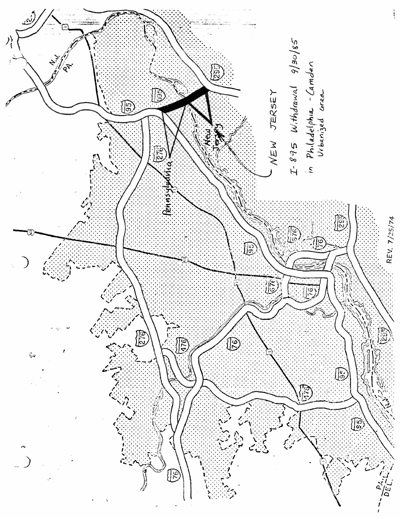
Withdrawal of I-95/695 -- New York City to Trenton, New Jersey
Description of Withdrawn Route
Interstate Route 95, the Maine-to-Florida Interstate link, was originally planned to connect Trenton, NJ with New York City by an alignment west of and generally parallel to U.S. Route 1.
Withdrawal Action
Shortly before leaving office, New Jersey Governor Brendan T. Byrne requested the withdrawal from the Interstate System of the 22.8-mile portion of I-95/695 between I-295 in the Trenton urbanized area and I-287 in the New York-Northeastern New Jersey urbanized area under the provisions of 23 U.S.C. 103(e)(4).
On March 29, 1982, Federal Highway Administrator R. A. Barnhart and Urban Mass Transportation Administrator Arthur E. Teele denied the request citing the fact that the routes were essential to the completion of a unified and connected Interstate System. The governor disagreed with the action and proceeded to initiate a legislative remedy.
Section 162 of the Surface Transportation Assistance Act of 1982 (P.L. 97-424), enacted January 6, 1983, provided for an alternate routing for I-95 via the Pennsylvania and New Jersey Turnpikes from just north of Philadelphia to south of New York City.
On March 3, 1983, Federal Highway Administrator R. A. Barnhart and Urban Mass Transportation Administrator Arthur E. Teele approved the withdrawal in accordance with Section 103(e)(4).
In accordance with Section 103(e)(4), New Jersey's unobligated balance of Interstate Construction (IC) funds was reduced by approximately $34.9 million on the date of the withdrawal. The reduction was accomplished by decreasing New Jersey's IC apportionment for FY 1983.
Withdrawal Value
The "Base" withdrawal value was based on the Federal share of the cost to complete I-95/695 as reported in the Interstate Cost Estimate (ICE) at the time of the withdrawal. The Base cost was adjusted quarterly to determine a new withdrawal value in accordance with Section 125 of the Federal-Aid Highway Amendments of 1974 reflecting variations in the cost of construction. The adjustment due to construction cost variances was terminated by the Surface Transportation Assistance Act of 1982. These values are shown in the following table:
| Base Cost (1981 ICE) | 210.9 million |
| Obligations for Highway Projects | 218.4 million |
| Obligations for Transit Projects | 20.5 million |
| Remaining Entitlement | 7.6 million |
| Final Withdrawal Value | 246.5 million |
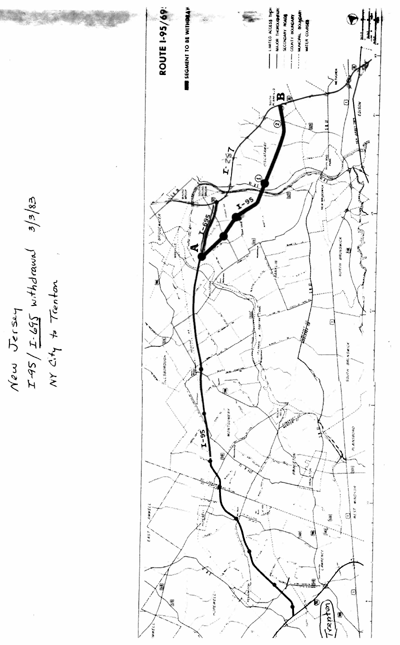
Withdrawal of I-687 -- Albany, New York
Description of Withdrawn Route
Interstate Route 687 was originally planned as a 3.6-mile connector between I-90 and I-87 in Albany.
Withdrawal Action
On February 16, 1978, Governor Hugh L. Carey requested the withdrawal of I-687 from the Interstate System.
On July 14, 1978, Acting Federal Highway Administrator Karl S. Bowers and Urban Mass Transportation Administrator Richard S. Page approved the withdrawal under the provisions of 23 U.S.C. 103(e)(4).
In accordance with Section 103(e)(4), New York's unobligated balance of Interstate Construction (IC) funds was reduced by approximately $2.0 million on the date of the withdrawal. The reduction was accomplished by decreasing New York's IC apportionment for FY 1978.
Withdrawal Value
The "Base" withdrawal value was based on the Federal share of the cost to complete I-687 as reported in the Interstate Cost Estimate (ICE) at the time of the withdrawal. The Base cost was adjusted quarterly to determine a new withdrawal value in accordance with Section 125 of the Federal-Aid Highway Amendments of 1974 reflecting variations in the cost of construction. The adjustment due to construction cost variances was terminated by the Surface Transportation Assistance Act of 1982. These values are shown in the following table:
| Base Cost (1977 ICE) | 35.2 million |
| Obligations for Highway Projects | 53.0 million |
| Obligations for Transit Projects | 6.1 million |
| Remaining Entitlement | 0.1 million |
| Final Withdrawal Value | 59.2 million |
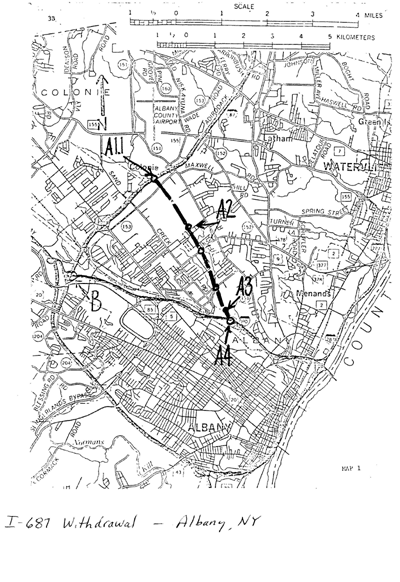
Withdrawal of I-495 and I-478 -- New York City, New York
Description of Withdrawn Route
The withdrawal of Interstate routes I-495 (Long Island Expressway) and I-478 (Westway) in New York City was accomplished in two stages.
Withdrawal Action
Stage One
The Long Island Expressway (I-495) was constructed as a six-lane facility between the Brooklyn-Queens (I-278) and Van Wyck (I-678) Expressways before the Interstate System and without Interstate Construction (IC) funding. It was incorporated into the Interstate System in September 1955, as part of the original 40,000-mile System. In 1963, FHWA approved additional lanes for the route. A 10-lane concept including 4 lanes elevated above the existing facility was adopted in the 1968 Interstate Cost Estimate and was eligible for IC funds.
On January 4, 1979, Governor Hugh L. Carey and Mayor Edward I. Koch joint requested the withdrawal from the Interstate System of this 4.7-mile section of the Long Island Expressway (I-495). New York's withdrawal value was based on the elevated additional lanes.
On June 29, 1979, Secretary Brock Adams approved the withdrawal under the provisions of 23 U.S.C. 103(e)(4).
In accordance with Section 103(e)(4), New York's unobligated balance of IC funds was reduced by approximately $14.5 million on the date of the withdrawal.
Stage Two
Interstate Route 478, the Westway project, was added to the Interstate System in 1971, and was planned to connect the Lincoln, Holland, and Brooklyn-Battery Tunnels along the Hudson River on the west side of Manhattan Island. For over a decade, the project was one of the most controversial projects in the country and was debated extensively by State and local officials, in the media, in Congress, and in the courts.
Section 107(b) of the 1978 STAA (P.L. 95-599) provided that withdrawal actions must be approved by September 30, 1983, unless the Interstate highway is under judicial injunction prohibiting its construction. Section 107(d) of the 1982 STAA (P.L. 97-424) modified this provision to require the Secretary's approval by September 30, 1985. Both of these provisions applied to the Westway project.
In an August 7, 1985, order by the U.S. District Court, the Corps of Engineers was enjoined from issuing a landfill permit and the FHWA was enjoined from approving funding of the project. Governor Mario M. Cuomo and Mayor Edward I. Koch then submitted a joint request by the State of New York and the New York City for the withdrawal of 4.26 miles of I-478 (Westway) from the Interstate System. On September 30, 1985, Secretary Elizabeth Hanford Dole approved the withdrawal under the provisions of 23 U.S.C. 103(e)(4).
Section 329 of the 1986 DOT Appropriations Act (P.L. 99-190) provided that New York could obligate IC funds for Interstate substitute highway projects under 23 U.S.C. 104(e)(4). It further provided that the withdrawal value for New York would be reduced by the amounts so obligated. The provision expired on October 1, 1986. New York obligated $164 million during FY 1986 under the provision. There was no adjustment to New York's unobligated balance of IC funds in accordance with 103(e)(4) as a result.
Withdrawal Value
The "Base" withdrawal value was based on the Federal share of the cost to complete I-495 and I-478 as reported in the Interstate Cost Estimate (ICE) at the time of the withdrawal. The Base cost was adjusted quarterly to determine a new withdrawal value in accordance with Section 125 of the Federal-Aid Highway Amendments of 1974 reflecting variations in the cost of construction. The adjustment due to construction cost variances was terminated by the Surface Transportation Assistance Act of 1982. These values are shown in the following table:
| Stage One Base Cost (1975 ICE) | 118.7 million |
| Stage Two Base Cost (1983 ICE) | 1,608.0 million |
| Obligations for Highway Projects | 1,045.2 million |
| Obligations for Transit Projects | 819.1 million |
| Remaining Entitlement | 11.9 million |
| Final Withdrawal Value | 1,876.2 million |
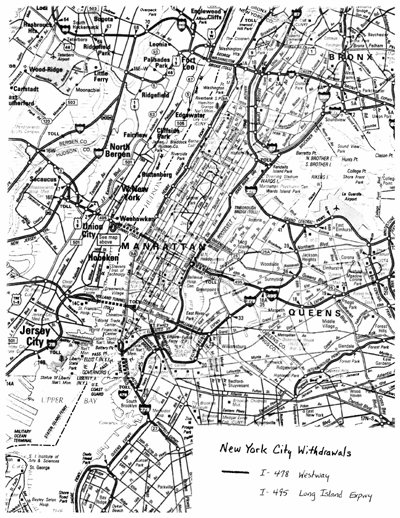
Withdrawal of I-490 -- Cleveland, Ohio
Description of Withdrawn Route
Interstate Route 490 was originally planned as a 9.6-mile connector between I-90/I-71 in Cleveland and I-480 in Garfield Heights.
Withdrawal Action
On November 9, 1979, Governor James A. Rhodes submitted a joint request by the State of Ohio and the City of Cleveland for the withdrawal from the Interstate System of a 7.9-mile section of I-490 between I-77 and I-480.
On November 13, 1979, Federal Highway Administrator Karl S. Bowers and Urban Mass Transportation Acting Deputy Administrator Lillian C. Liburdi approved the withdrawal under the provisions of 23 U.S.C. 103(e)(4).
The 1.7-mile portion of I-490 between I-90/I-71 and I-77 remained on the Interstate System and was eventually constructed.
In accordance with Section 103(e)(4), Ohio's unobligated balance of Interstate Construction (IC) funds was reduced by approximately $12.6 million on the date of the withdrawal. The reduction was accomplished by reducing Ohio's IC apportionment for FY 1980.
Withdrawal Value
The "Base" withdrawal value was based on the Federal share of the cost to complete I-490 as reported in the Interstate Cost Estimate (ICE) at the time of the withdrawal. The Base cost was adjusted quarterly to determine a new withdrawal value in accordance with Section 125 of the Federal-Aid Highway Amendments of 1974 reflecting variations in the cost of construction. The adjustment due to construction cost variances was terminated by the Surface Transportation Assistance Act of 1982. These values are shown in the following table:
| Base Cost (1977 ICE) | 147.9 million |
| Obligations for Highway Projects | 211.6 million |
| Obligations for Transit Projects | 49.2 million |
| Remaining Entitlement | 2.1 million |
| Final Withdrawal Value | 262.9 million |
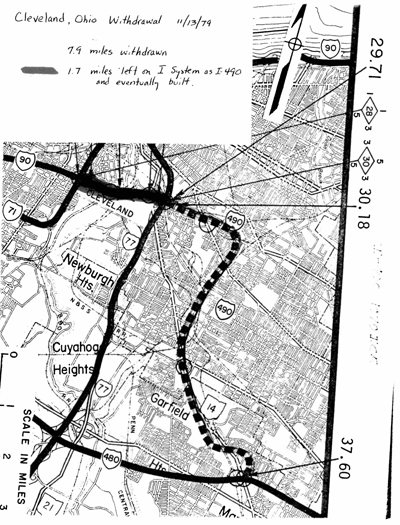
Withdrawal of I-80N, I-505 and I-205 (Bus Lanes) -- Portland, Oregon
Description of Withdrawn Route
The withdrawals of I-80N, I-505, and bus lanes on I-205 in Portland was accomplished in three stages.
Withdrawal Action
Stage One
I-80N originally was planned to extend from I-5 in Portland, Oregon to the vicinity of Salt Lake City, Utah. The segment in Portland between I-5 and I-205 was termed the Mt. Hood Freeway, and was controversial with local officials. The remainder of the route between Portland and Salt Lake City was eventually completed and renumbered as I-84.
On July 1, 1975, as amended on February 24, 1976, Governor Robert W. Straub requested the withdrawal of a portion of a 5.1-mile portion of I-80N between I-5 and I-205 from the Interstate System.
On May 3, 1976, Federal Highway Administrator Norbert T. Tiemann and Urban Mass Transportation Administrator Robert E. Petricelli approved the withdrawal under the provisions of 23 U.S.C. 103(e)(4).
In accordance with Section 103(e)(4), Oregon's unobligated balance of Interstate Construction (IC) funds was reduced by approximately $34.7 million on the date of the withdrawal. The reduction was accomplished by decreasing Oregon's IC apportionment for FYs 1975-1977.
Stage Two
I-505, named the Industrial Freeway, was originally planned to extend as a 3.3-mile spur from I-405 to U.S. 30 adjacent to the Williamette River.
On September 13, 1979, Governor Victor Atiyeh requested the withdrawal of all of I-505 from the Interstate System.
On December 14, 1979, Federal Highway Administrator Karl S. Bowers and Urban Mass Transportation Acting Deputy Administrator Lillian C. Liburdi approved the withdrawal under the provisions of 23 U.S.C. 103(e)(4).
In accordance with Section 103(e)(4), Oregon's unobligated balance of IC funds was reduced by approximately $3.6 million on the date of the withdrawal. The reduction was accomplished by decreasing Oregon's IC apportionment for FY 1980.
Stage Three
Section 142 of the 1987 Surface Transportation and Uniform Relocation Assistance Act (P.L. 100-17) provided for the substitution of light-rail transit in the I-205 corridor in lieu of bus lanes on I-205 which were eligible for IC funding.
On May 30, 1989, Governor Neil Goldschmidt requested the withdrawal of the I-205 bus lanes and substitution of light-rail.
On September 22, 1989, Federal Highway Administrator Thomas D. Larson and Urban Mass Transportation Deputy Administrator Roland J. Mross approved the withdrawal under the provisions of 23 U.S.C. 103(e)(4).
In accordance with Section 103(e)(4), Oregon's unobligated balance of IC funds was reduced by approximately $0.6 million on the date of the withdrawal. The reduction was accomplished by decreasing Oregon's IC apportionment for FY 1990.
Withdrawal Value
The "Base" withdrawal value was based on the Federal share of the cost to complete I-80N, I-505, and I-205 as reported in the Interstate Cost Estimate (ICE) at the time of the withdrawal. The Base cost was adjusted quarterly to determine a new withdrawal value in accordance with Section 125 of the Federal-Aid Highway Amendments of 1974 reflecting variations in the cost of construction. The adjustment due to construction cost variances was terminated by the Surface Transportation Assistance Act of 1982. These values are shown in the following table:
| Stage One Base Cost (1975 ICE) | 145.5 million |
| Stage Two Base Cost (1979 ICE) | 98.6 million |
| Stage Three Base Cost (1989 ICE) | 16.4 million |
| Obligations for Highway Projects | 342.2 million |
| Obligations for Transit Projects | 174.4 million |
| Remaining Entitlement | 1.1 million |
| Final Withdrawal Value | 517.8 million |
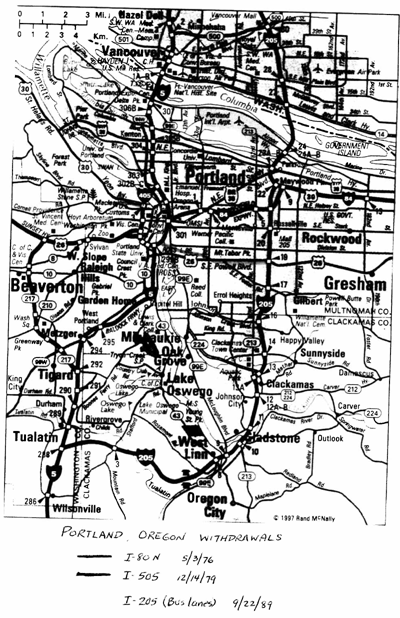
Withdrawal of I-305 -- Salem, Oregon
Description of Withdrawn Route
Interstate Route 305 was originally planned as a 3.3-mile spur from the north into Salem.
Withdrawal Action
In letters dated January 18 and May 31, 1977, Governor Robert W. Straub requested the withdrawal of I-305 from the Interstate System.
On September 30, 1977, Federal Highway Administrator William M. Cox and Urban Mass Transportation Administrator Richard S. Page approved the withdrawal under the provisions of 23 U.S.C. 103(e)(4).
In accordance with Section 103(e)(4), Oregon's unobligated balance of Interstate Construction (IC) funds was reduced by approximately $6.2 million on the date of the withdrawal. The reduction was accomplished by decreasing Oregon's IC apportionment for FY 1977.
Withdrawal Value
The "Base" withdrawal value was based on the Federal share of the cost to complete I-305 as reported in the Interstate Cost Estimate (ICE) at the time of the withdrawal. The Base cost was adjusted quarterly to determine a new withdrawal value in accordance with Section 125 of the Federal-Aid Highway Amendments of 1974 reflecting variations in the cost of construction. The adjustment due to construction cost variances was terminated by the Surface Transportation Assistance Act of 1982. These values are shown in the following table:
| Base Cost (1977 ICE) | 32.5 million |
| Obligations for Highway Projects | 56.8 million |
| Obligations for Transit Projects | 0.0 million |
| Remaining Entitlement | 0.0 million |
| Final Withdrawal Value | 56.8 million |
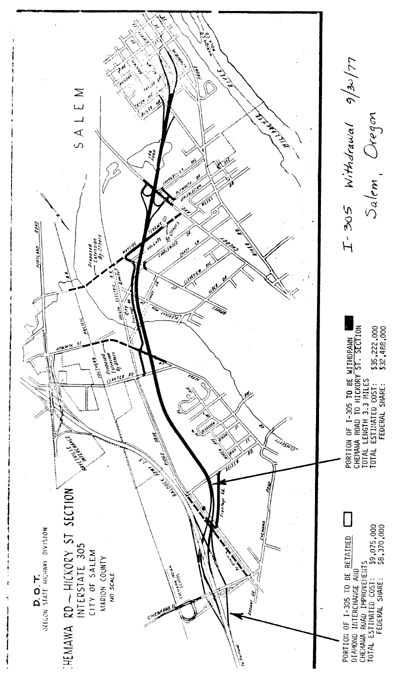
Withdrawal of I-695 & I-895 -- Philadelphia, Pennsylvania
Description of Withdrawn Route
The withdrawals of Interstate Routes 695 and 895 were accomplished in two stages.
Withdrawal Action
Stage One
Interstate 695, the Cobb's Creek Expressway, was originally intended to connect I-76 near downtown Philadelphia with I-95 in the vicinity of Philadelphia International Airport, a total length of 7.8 miles.
On May 8, 1974, Governor Milton J. Sharp requested the withdrawal of I-695 from the Interstate System.
On June 25, 1974, Federal Highway Administrator Norbert T. Tiemann and Urban Mass Transportation Administrator Frank C. Herringer approved the withdrawal under the provisions of 23 U.S.C. 103(e)(4).
In accordance with Section 103(e)(4), Pennsylvania's unobligated balance of Interstate Construction (IC) funds was increased by approximately $38.1 million on the date of the withdrawal. The increase was accomplished by increasing Pennsylvania's IC apportionment for FY 1977.
Stage Two
I-895 was originally intended as a 6.4 mile connection from I-95 in Philadelphia across the Delaware River to I-295 (the New Jersey Turnpike) in New Jersey in the Philadelphia-Camden urbanized area.
On September 25, 1980, Governor Dick Thornburgh requested the withdrawal of the portion of I-895 in Pennsylvania from the Interstate System. A similar request was received from New Jersey for their portion of the route.
On September 30, 1980, Federal Highway Administrator John S. Hassell and Urban Mass Transportation Administrator Theodore C. Lutz approved the withdrawal under the provisions of 23 U.S.C. 103(e)(4). The New Jersey request was also approved on the same date.
In accordance with Section 103(e)(4), Pennsylvania's unobligated balance of Interstate Construction (IC) funds was reduced by approximately $8.6 million on the date of the withdrawal. The reduction was accomplished by reducing Pennsylvania's IC apportionment forFY 1980.
Withdrawal Value
The "Base" withdrawal value was based on the Federal share of the cost to complete I-695 and I-895 as reported in the Interstate Cost Estimate (ICE) at the time of the withdrawal. The Base cost was adjusted quarterly to determine a new withdrawal value in accordance with Section 125 of the Federal-Aid Highway Amendments of 1974 reflecting variations in the cost of construction. The adjustment due to construction cost variances was terminated by the Surface Transportation Assistance Act of 1982. These values are shown in the following table:
| Stage One Base Cost (1979 ICE) | 148.2 million |
| Stage Two Base Cost (1979 ICE) | 81.9 million |
| Obligations for Highway Projects | 135.7 million |
| Obligations for Transit Projects | 343.8 million |
| Remaining Entitlement | 0.7 million |
| Final Withdrawal Value | 480.1 million |
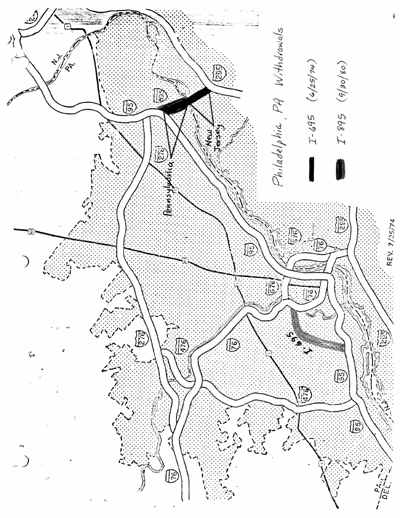
Withdrawal of I-579 -- Pittsburgh, Pennsylvania
Description of Withdrawn Route
Interstate Route 579, known as the "Crosstown Boulevard" was originally planned as a 1.7-mile connection between I-376 (Penn Lincoln Parkway) and I-279 by traversing downtown Pittsburgh and the Allegheny River.
Withdrawal Action
On September 28, 1979, Governor Dick Thornburgh requested the withdrawal of a 0.4-mile portion of I-579 from the Interstate System. The 0.4-mile segment was at the southern terminus of the route and effectively terminated the route at the Boulevard of the Allies rather than at I-376.
On December 14, 1979, Federal Highway Administrator Karl S. Bowers and Urban Mass Transportation Acting Deputy Administrator Lillian C. Liburdi approved the withdrawal under the provisions of 23 U.S.C. 103(e)(4).
In accordance with Section 103(e)(4), Pennsylvania's unobligated balance of Interstate Construction (IC) funds was reduced by approximately $1.8 million on the date of the withdrawal. The reduction was accomplished by decreasing Pennsylvania's IC apportionment for FY 1980.
Withdrawal Value
The "Base" withdrawal value was based on the Federal share of the cost to complete I-579 as reported in the Interstate Cost Estimate (ICE) at the time of the withdrawal. The Base cost was adjusted quarterly to determine a new withdrawal value in accordance with Section 125 of the Federal-Aid Highway Amendments of 1974 reflecting variations in the cost of construction. The adjustment due to construction cost variances was terminated by the Surface Transportation Assistance Act of 1982. These values are shown in the following table:
| Base Cost (1979 ICE) | 39.5 million |
| Obligations for Highway Projects | 65.7 million |
| Obligations for Transit Projects | 0.0 million |
| Remaining Entitlement | 0.3 million |
| Final Withdrawal Value | 66.0 million |
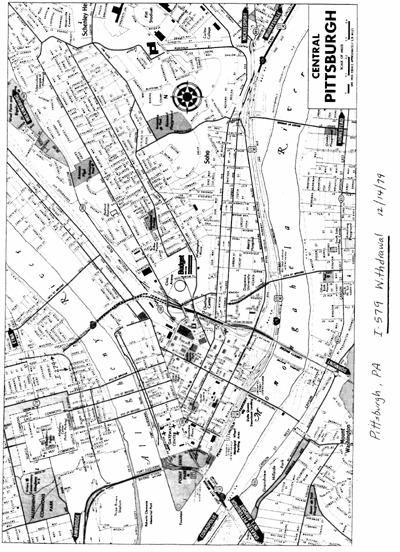
Withdrawal of I-985 and I-84 -- Rhode Island
The withdrawal of I-895 and I-84 in Rhode Island was accomplished in two stages.
Withdrawal Action
Stage One
Route 895 was originally planned as a 39.6-mile loop south of Providence from I-95 in the southwest corner of Rhode Island via Newport to the Massachusetts State Line near Fall River, Massachusetts.
On October 22, 1981, Governor J. Joseph Garrahy requested the withdrawal of the entire 39.6 miles of I-895 from the Interstate System. He was subsequently advised that only the urban easterly 25.52 miles could be withdrawn; the westerly rural 14.09 miles was not eligible for withdrawal under then existing law. In a February 5, 1982, letter the governor revised his request to remove the western rural portion.
On December 30, 1982, Federal Highway Administrator R. A. Barnhart and Urban Mass Transportation Administrator Arthur E. Teele approved the withdrawal of the urban mileage under the provisions of 23 U.S.C. 103(e)(4). The rural mileage was deleted from the System under 103(f).
However, in a May 20, 1983, letter to Governor Garrahy, Administrators Barnhart and Teele admitted that they had made administrative errors in approving the earlier withdrawal. Specifically, at the time of the approval, both houses of Congress had approved an identical provision that made rural Interstate segments, like I-895, eligible for withdrawal. The provision was included in the 1982 STAA (P.L. 97-424) which President Reagan signed into law on January 6, 1983. Therefore, in their May letter the administrators rescinded their earlier limited approval and approved the withdrawal of the entire 39.6-mile route.
Jamestown Bridge
A further complication with the I-895 withdrawal involved the Jamestown Bridge at Newport. The proposed alignment of I-895 provided for construction of a new replacement Jamestown structure just south of the existing bridge. With the advice of FHWA, in the original 1982 I-895 withdrawal, the cost of the replacement structure as included in the Interstate Cost Estimate was not used in computing the State's Interstate Substitution entitlement. This omission was intentional based on Mr. Barnhart's indication to the State that they could expect to receive Bridge Discretionary funds for the bridge if it didn't duplicate an Interstate Substitution entitlement.
However, later the State reconsidered and asked that the ICE costs for the bridge be included in their substitution entitlement. In his July 5, 1983, memorandum Director of Engineering Phillips indicated that since the State now indicated it would agree to the reduction of its Interstate Substitution entitlement dollar-for-dollar for any Bridge Discretionary funds received for the Jamestown Bridge, that the Substitution entitlement would be changed to include the Jamestown Bridge. Mr. Barnhart confirmed the approval of the State's reconsidered proposal in his July 14 letter to the Rhode Island DOT.
In accordance with Section 103(e)(4), Rhode Island's unobligated balance of Interstate Construction (IC) funds was reduced to reflect the I-895 withdrawal. Because the withdrawal involved three steps, the reduction took three steps:
- Mr. Barnhart's January 21, 1983, letter reduced the State's IC balance by $46.1 million based on withdrawal of the rural portion of I-895.
- Mr. Barnhart's June 13, 1983, letter rescinded the January reduction and reduced the State's IC balance by $66.7 million based on withdrawal of the entire (urban and rural portions) I-895.
- Mr. Barnhart's July 14, 1983, letter reduced the State's IC balance by an additional $19.2 million based on inclusion of the Jamestown Bridge costs in the withdrawal value.
Stage Two
Route 84 was originally planned as a major east-west facility extending from Scranton, PA via Newburgh, NY, and Hartford, CT to Providence, RI. The sections west of Hartford were essentially built as planned. The Hartford-to-Providence segment was withdrawn and mostly not constructed, and I-84 in Connecticut was rerouted to the Wilbur-Cross Parkway between Hartford and Massachusetts.
On June 28, 1983, Governor J. Joseph Garrahy requested the withdrawal of I-84 in Rhode Island from the Interstate System.
On September 20, 1983, Federal Highway Administrator R. A. Barnhart and Urban Mass Transportation Acting Administrator G. Kent Woodman approved the withdrawal under the provisions of 23 U.S.C. 103(e)(4).
In accordance with Section 103(e)(4), Rhode Island's unobligated balance of IC funds was reduced by approximately $5.3 million on the date of the withdrawal. The reduction was accomplished by decreasing Rhode Island's IC apportionment for FY 1984.
Withdrawal Value
The "Base" withdrawal value was based on the Federal share of the cost to complete I-895 and I-84 as reported in the Interstate Cost Estimate (ICE) at the time of the withdrawal. The Base cost was adjusted quarterly to determine a new withdrawal value in accordance with Section 125 of the Federal-Aid Highway Amendments of 1974 reflecting variations in the cost of construction. The adjustment due to construction cost variances was terminated by the Surface Transportation Assistance Act of 1982. These values are shown in the following table:
| Stage One Base Cost (1981 ICE) | 479.1 million |
| Stage Two Base Cost (1981 ICE) | 112.0 million |
| Obligations for Highway Projects | 610.3 million |
| Obligations for Transit Projects | 32.4 million |
| Remaining Entitlement | 4.6 million |
| Final Withdrawal Value | 647.3 million |
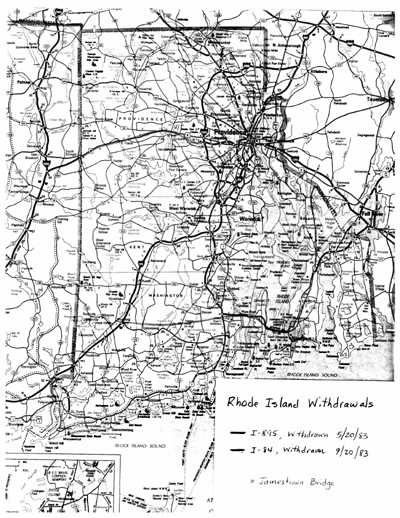
Withdrawal of I-40 -- Memphis, Tennessee
Description of Withdrawn Route
Interstate Route is an East-West transcontinental route extending from California to North Carolina. In Memphis, I-40 was originally planned along an alignment in Central Memphis through Overton Park and the Memphis city zoo. The park alignment, even though planned as a cut-and-cover tunnel was extremely controversial with environmentalists and park preservationists. This highway segment was one of the prime examples which led to passage of Section 4(f) of the 1966 act creating the Department of Transportation. The act prohibited highway construction in parks unless there were no prudent or feasible alternative.
Withdrawal Action
On January 8, 1981, Governor Lamar Alexander requested the withdrawal from the Interstate System of a 3.8-mile segment of I-40 between Claybrook Street and Malcomb Street.
On January 16, 1981, Federal Highway Administrator John S. Hassell and Urban Mass Transportation Administrator Theodore C. Lutz approved the withdrawal under the provisions of 23 U.S.C. 103(e)(4). In addition, a 0.3-mile segment west of the withdrawn portion and a 4.)-mile segment east of the withdrawn portion had already been constructed and were removed from the System under 103(f). As a result, all of I-40 between the I-40/I-240 interchange on the west to the I-40/I-240 interchange on the east were removed from the Interstate System.
Route continuity for I-40 was maintained by renumbering the I-240 loop around the north side of Memphis as I-40.
In accordance with Section 103(e)(4), Tennessee's unobligated balance of Interstate Construction (IC) funds was reduced by approximately $8.3 million on the date of the withdrawal. The reduction was accomplished by reducing Tennessee's IC apportionment for FY 1982.
Withdrawal Value
The "Base" withdrawal value was based on the Federal share of the cost to complete I-40 as reported in the Interstate Cost Estimate (ICE) at the time of the withdrawal. The Base cost was adjusted quarterly to determine a new withdrawal value in accordance with Section 125 of the Federal-Aid Highway Amendments of 1974 reflecting variations in the cost of construction. The adjustment due to construction cost variances was terminated by the Surface Transportation Assistance Act of 1982. These values are shown in the following table:
| Base Cost (1979 ICE) | 171.6 million |
| Obligations for Highway Projects | 248.7 million |
| Obligations for Transit Projects | 37.0 million |
| Remaining Entitlement | 1.8 million |
| Final Withdrawal Value | 287.5 million |
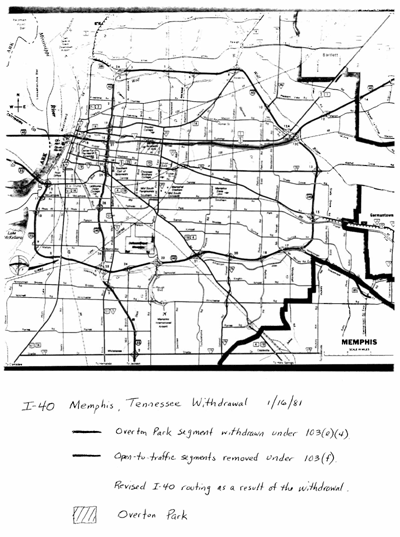
Withdrawal of I-266 & I-595 in Northern Virginia
Description of Withdrawn Route
Interstate Routes 266 and 595 in the Northern Virginia suburbs of Washington, DC, were withdrawn from the Interstate System under 23 U.S.C. 103(e)(4) in two stages as discussed below.
Withdrawal Action
Stage One
I-266 in Virginia was originally intended as a 0.4-mile route connecting the Three Sisters Bridge over the Potomac River in the District of Columbia to I-44 in Arlington via Spout Run Parkway corridor. On April 29, 1977, DC's request to withdraw the Three Sisters Bridge had been approved by FHWA and UMTA.
On January 30, 1978, Governor John N. Dalton requested the withdrawal of all of I-266 in Virginia from the Interstate System.
On August 16, 1978, Federal Highway Acting Administrator Karl S. Bowers and Urban Mass Transportation Administrator Richard S. Page approved the withdrawal under the provisions of 23 U.S.C. 103(e)(4).
In accordance with Section 103(e)(4), Virginia's unobligated balance of Interstate Construction (IC) funds was reduced by approximately $20 thousand on the date of the withdrawal. The reduction was accomplished by reducing Virginia's IC apportionment for FY 1979.
Stage Two
I-595 was originally intended as a 1.13-mile spur from I-95 (later renumbered as I-395) in the vicinity of the Pentagon southward to National Airport. The northerly 0.29-mile segment connecting to I-395 was constructed and opened to traffic.
On July 1, 1982, Governor Charles S. Robb requested the withdrawal of the 0.84-mile unbuilt portion of I-595 from the Interstate System. The 0.29-mile segment previously open-to-traffic was removed from the System under Section 103(f).
On August 27, 1982, Federal Highway Administrator R. A. Barnhart and Urban Mass Transportation Administrator Arthur E. Teele approved the withdrawal under the provisions of 23 U.S.C. 103(e)(4).
In accordance with Section 103(e)(4), Virginia's unobligated balance of IC funds was reduced by approximately $0.3 million on the date of the withdrawal. The reduction was accomplished by reducing Virginia's IC apportionment for FY 1983.
Withdrawal Value
The "Base" withdrawal value was based on the Federal share of the cost to complete I-266 and I-595 as reported in the Interstate Cost Estimate (ICE) at the time of the withdrawal. The Base cost was adjusted quarterly to determine a new withdrawal value in accordance with Section 125 of the Federal-Aid Highway Amendments of 1974 reflecting variations in the cost of construction. The adjustment due to construction cost variances was terminated by the Surface Transportation Assistance Act of 1982. These values are shown in the following table:
| Stage One Base Cost (1977 ICE) | 35.6 million |
| Stage Two Base Cost (1981 ICE) | 22.6 million |
| Obligations for Highway Projects | 26.4 million |
| Obligations for Transit Projects | 51.7 million |
| Remaining Entitlement | 0.0 million |
| Final Withdrawal Value | 78.2 million |
